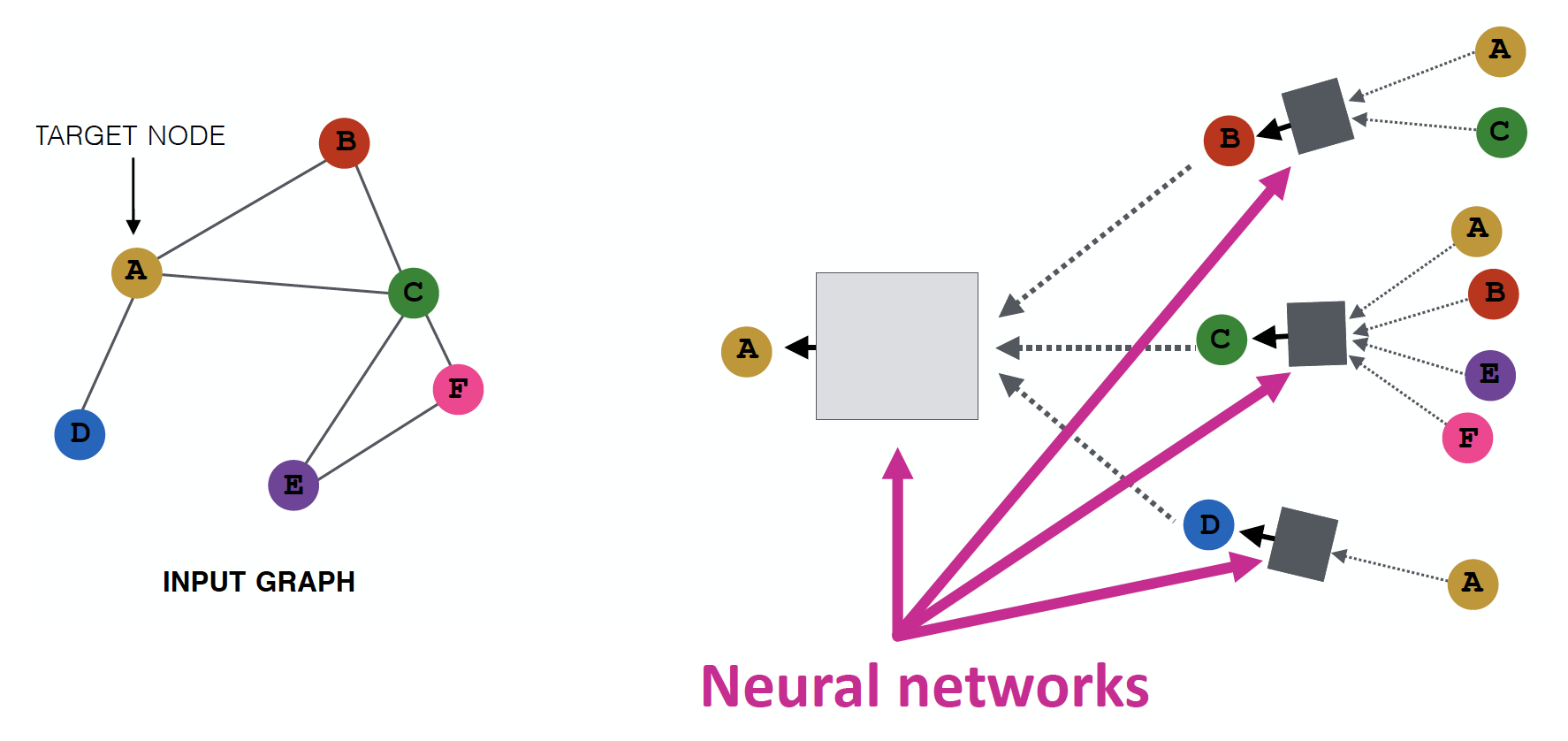
작성자 : 이재빈
Contents
- Intro
- Deep Learning for Graphs
- Graph Convolutional Network
- Graph Attention Network
- Application
Keyword : Deep Learning on Graph , Neighborhood Aggregation , GNN , GCN , GAT
0. Intro
Node Embedding
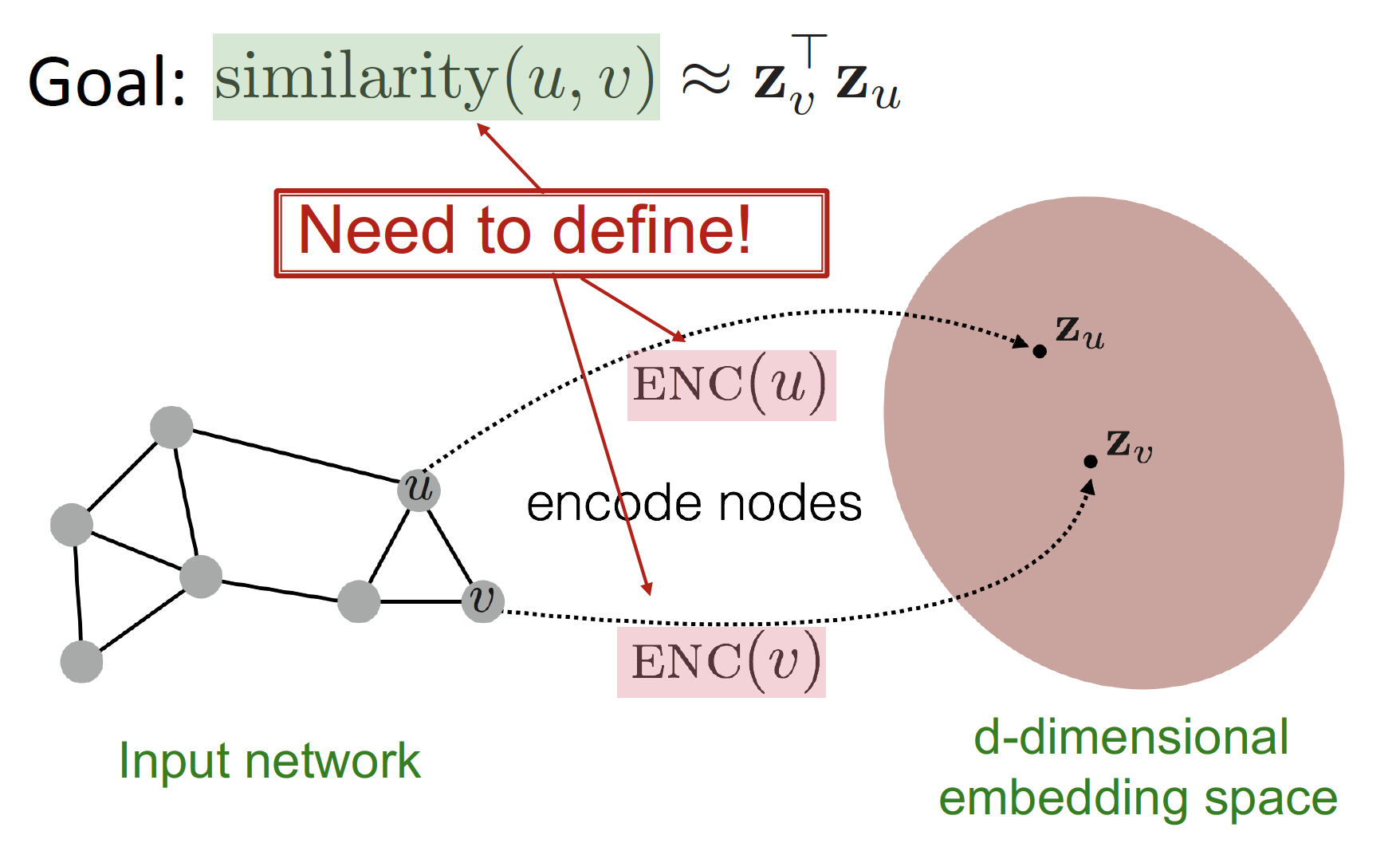
7강에서는 Node Embedding 에 대해 공부했습니다.
embedding node (, ) 사이의 관계가 original network node (, ) 사이의 관계 (Similarity) 를 가장 잘 표현해 주는 encoder () 를 찾는 방법을 배웠습니다.
From "Shallow" to "Deep"
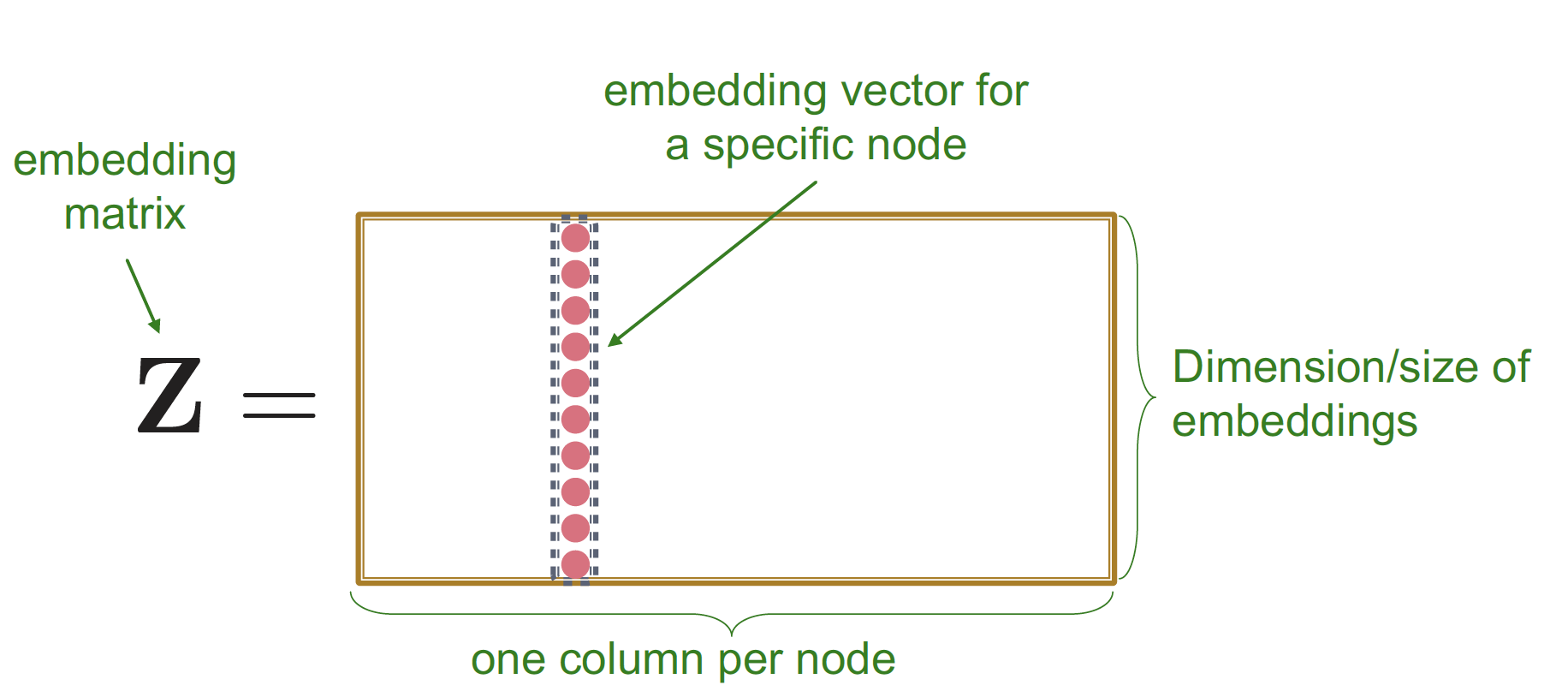
이 때 Shallow Encoder (Lookup table) 를 공부했습니다.
Shallow Encoder는 single layer () 로 구성되어 있으며, 이를 통해 node embedding 을 진행하고 ( → ), similarity () 를 계산합니다.
Limitations of Shallow Embedding
- parameters are needed
- parameter 개수 = # of nodes
node 끼리 parameter 를 공유하지 않습니다. - 각 node 들은 unique embedding 값을 가지게 됩니다.
- parameter 개수 = # of nodes
- Inherently "transductive"
- I have to re-embed everything
- train 과정에서 보지 않은 node/embedding 을 generalize 할 수 없습니다.
- Do not incorporate node features
- node attribute feature 를 사용하지 않습니다.
Deep Graph Encoders

따라서 위의 한계를 극복하고자, multiple layer 로 구성된 Deep Encoder 를 고려하게 됩니다.
Challenges
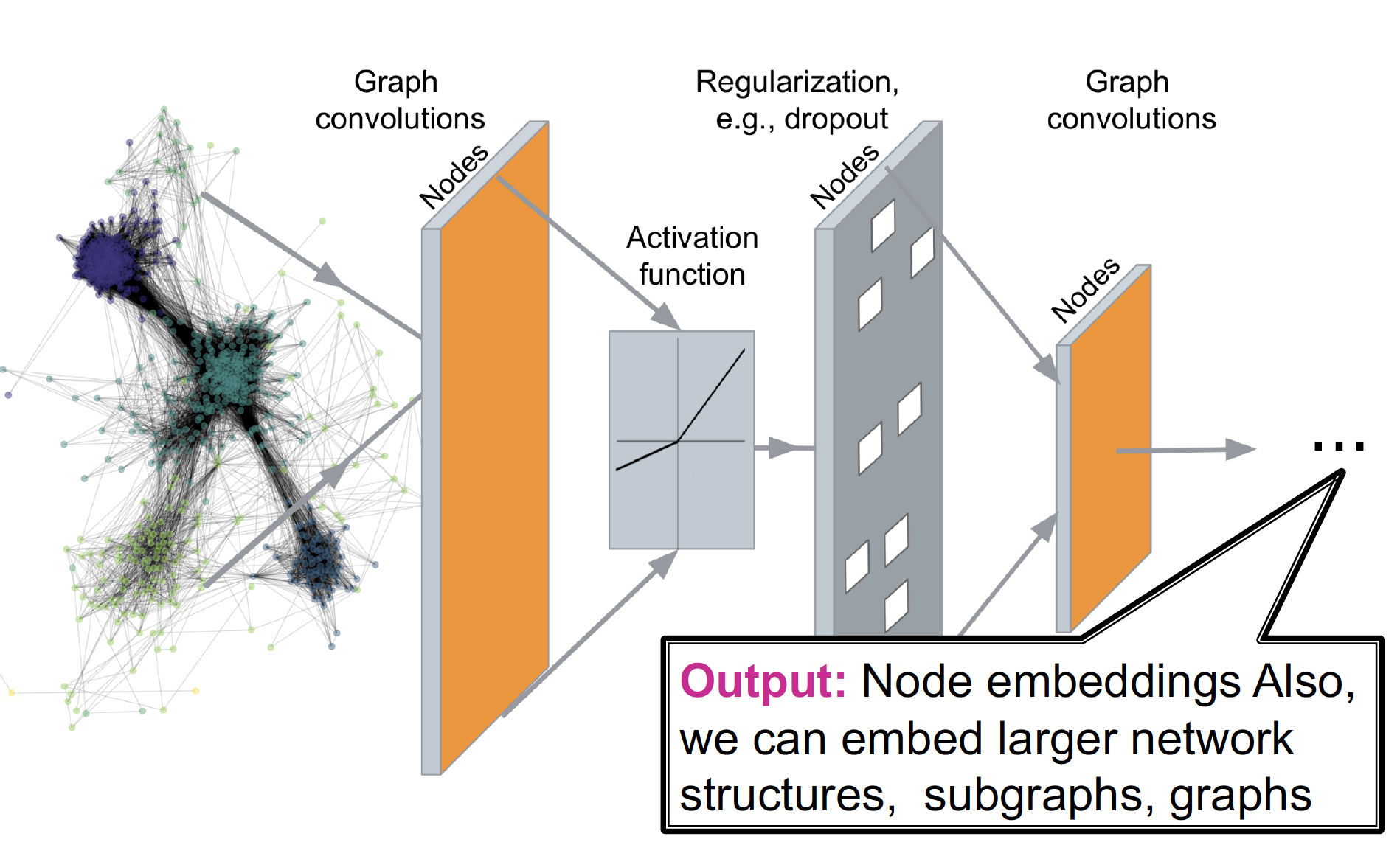
Graph Network 를 Deep Neural Network 구조에 통과시켜서, node embedding (good prediction) 을 만들어 내고 싶지만, 이는 쉽지 않습니다.

단순하게 Deep Learning을 적용하기에는, 실제 Network가 매우 복잡하기 때문입니다.
- 현존하는
ML/DL ToolBox는 Image (Grids = Fixed Size Graph) & Text (Sequences = Line Graph) 에 특화되어 있습니다. - Network는 위상학적으로 매우 복잡한 구조를 가지고 있습니다.
- node들은 고정된 순서 & 기준점이 없습니다.
- dynamic 하며, Multimodal features를 갖는 경우도 있습니다.
A Naive Approach

Adjacency matrix 와 Feature vector 를 concat 해서 Deep Neural Network 의 input 으로 넣는 방법 또한 적용이 어렵습니다.
Issues
- : parameter 개수 (node + feature) 가 많아집니다.
- different size 의 graph 에 적용할 수 없습니다.
- node 의 순서가 바뀌면, 의미가 달라질 수 있습니다.
- Adj node 의 ordering 이 shuffle 될 수도 있습니다.
- 2 additional feature node 를 어디에 넣어야 할지 모호해집니다.
idea : Convolutional Networks
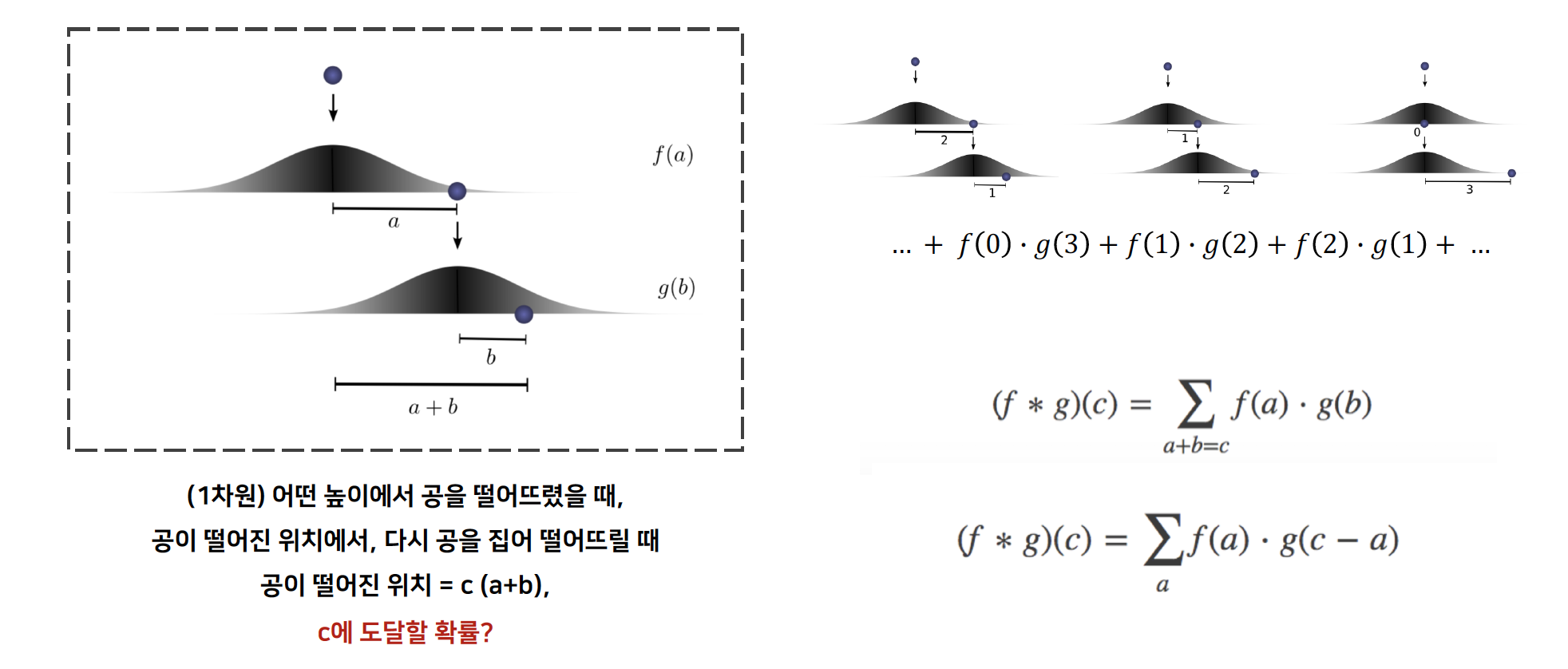
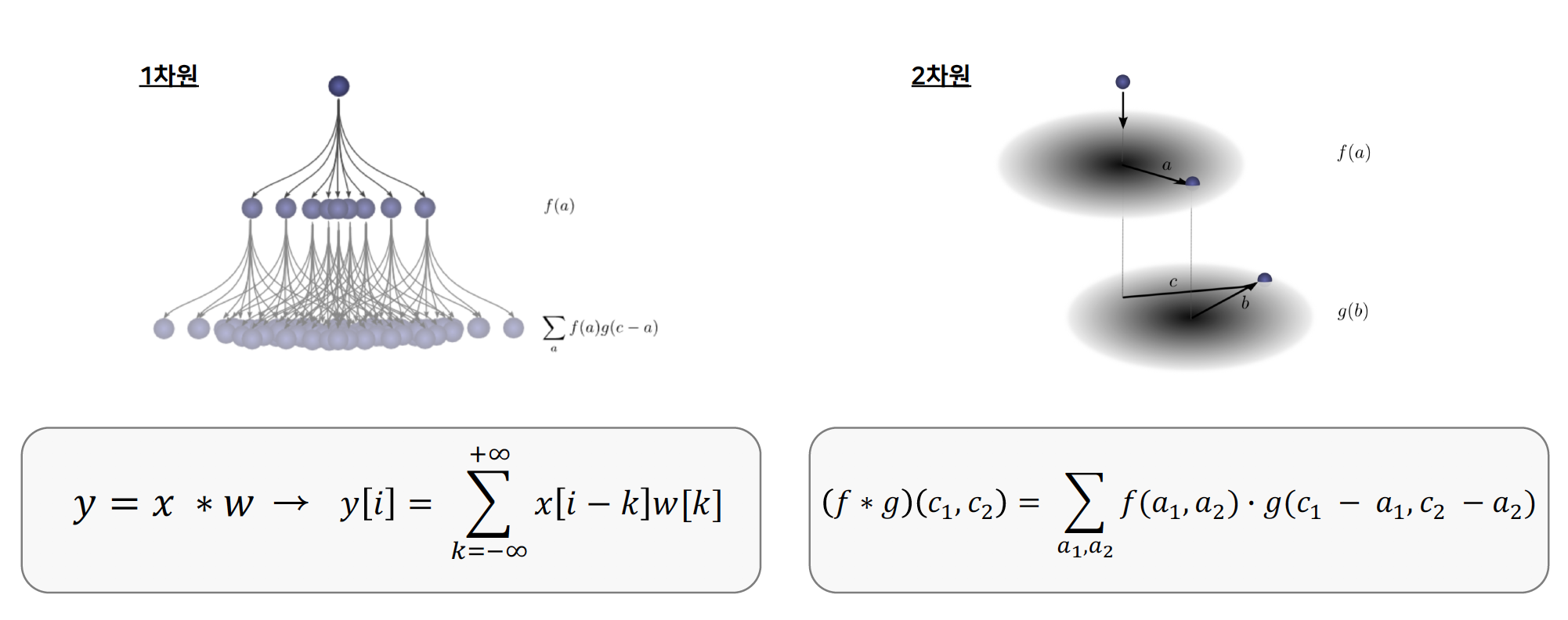
Convolutional 연산의 원리는 위와 같습니다.
sliding window 통해 얻은 정보를 다 더하여, output 을 도출합니다.
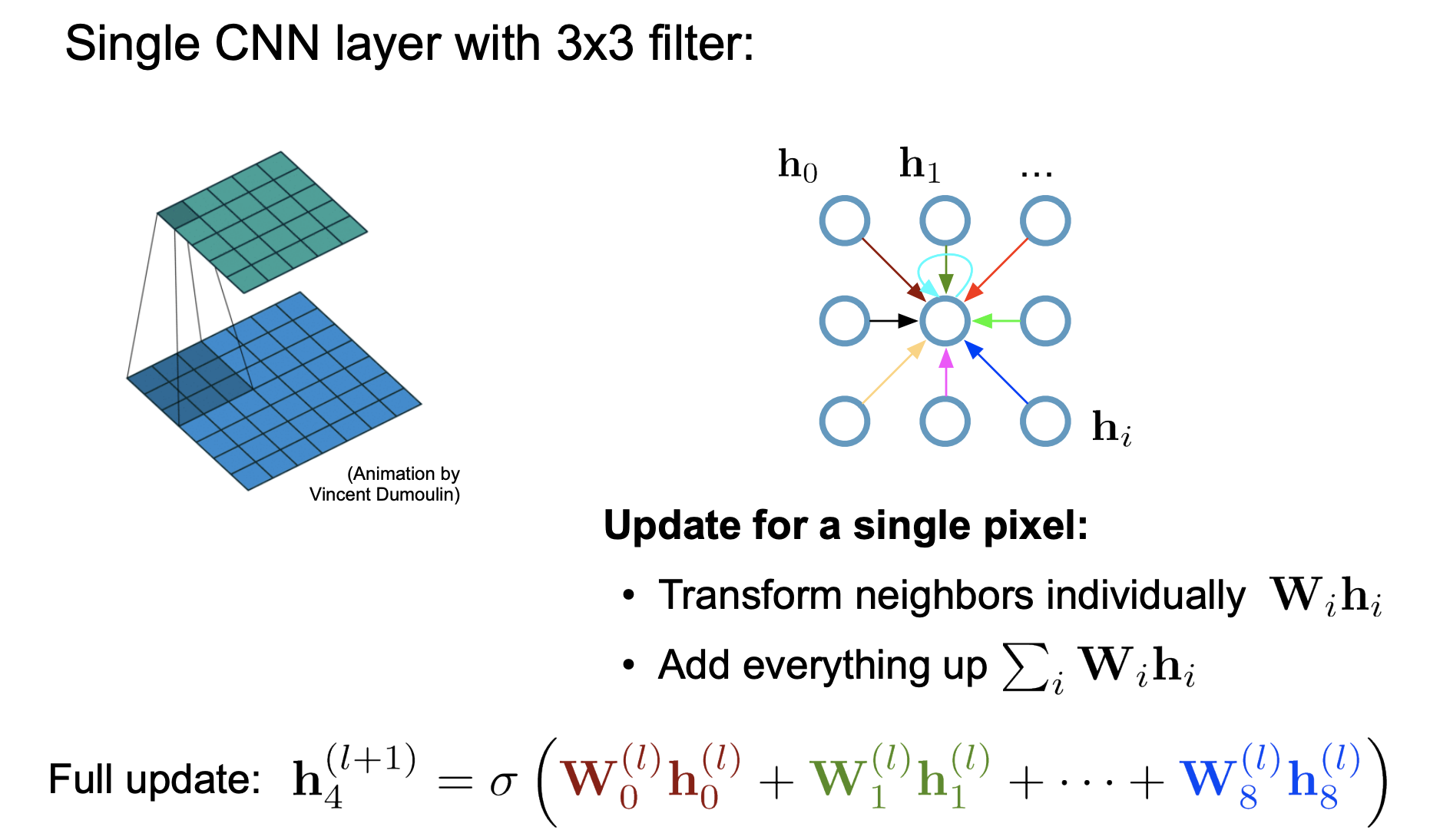
neighborhood 의 message 를 collect 하여, node 의 message 와 combine 하고, 이를 통해 new value 를 produce 하고자 합니다.
이러한 과정을 가장 잘 수행할 수 있는 연산 방법이 ConV 이기 때문에,
Convolutional 을 graph 에 적용해서, information 을 aggregate 하고자 합니다.
1. Deep Learning for Graphs
Setup
graph 에 대하여,
- : vertex set = node 집합
- : Adjacency matrix = 인접행렬
- : Node Feature matrix
Graph Convolutional Networks
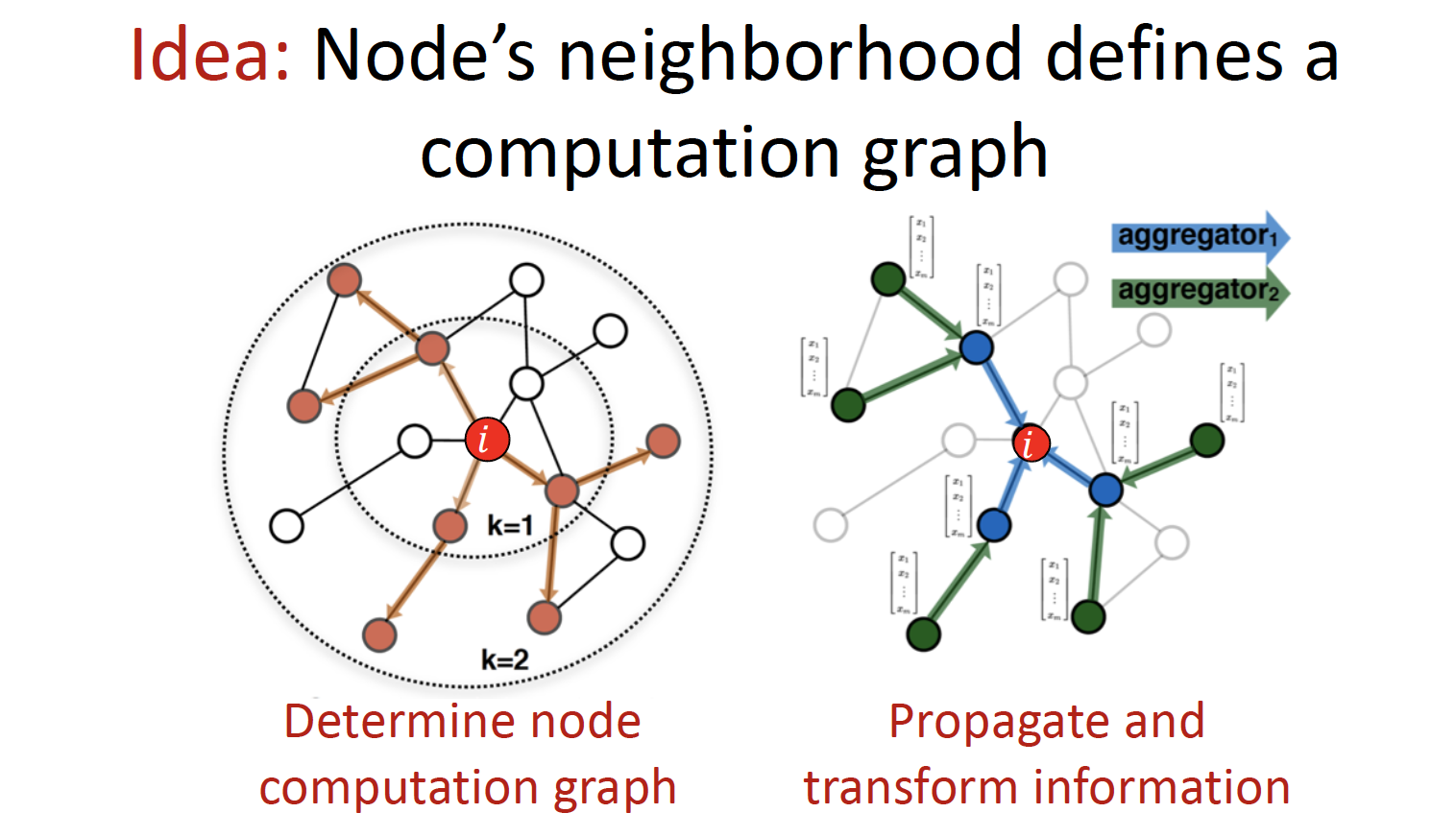
Learn how to propagate information across the graph to compute node features
node i 에 대한 prediction 을 하고 싶을 때,
1. node computation graph 를 결정하고,
2. neighborhood information 을 propagate 하고 aggregate 합니다.
Aggregate Neighbors
Key idea
Local Network Neighborhoods 정보를 기반으로 node embedding 을 진행합니다.
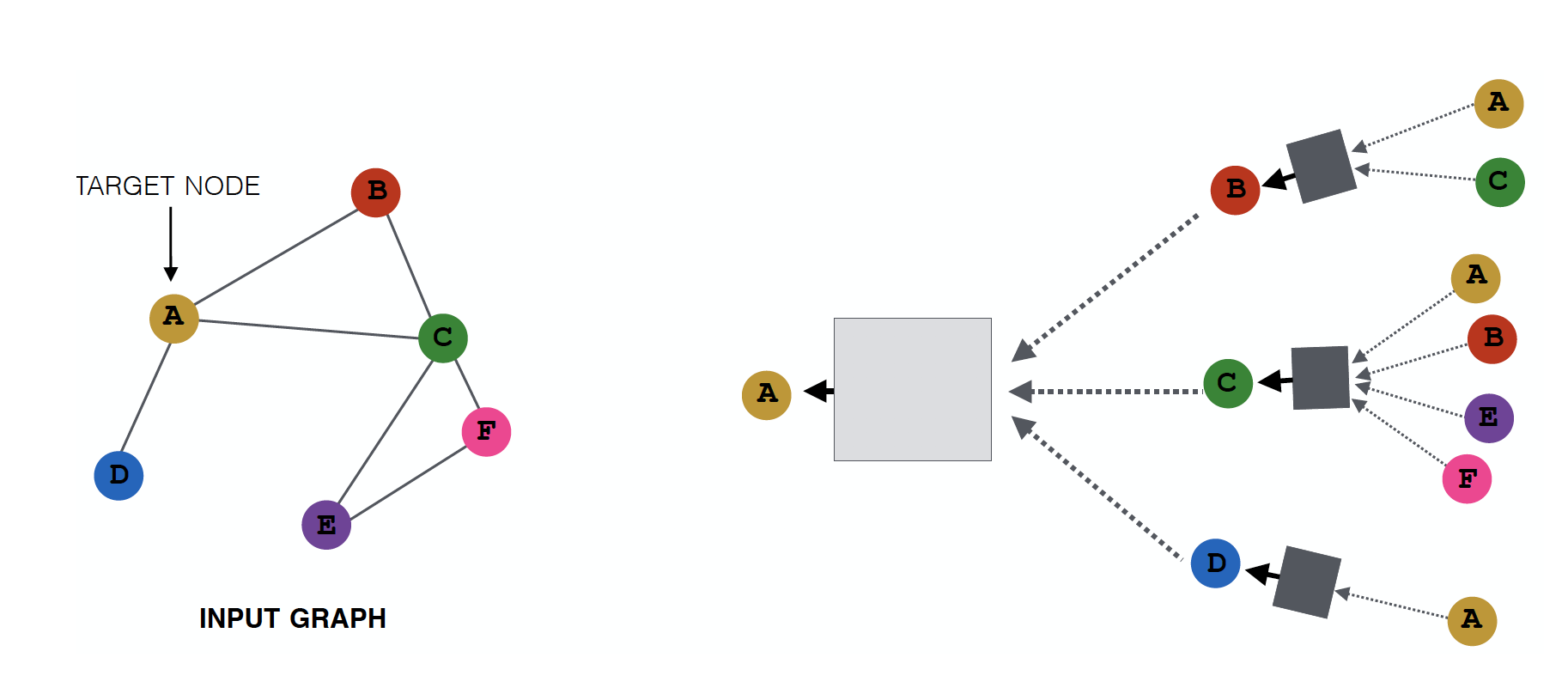
- node B 는 A, C 로 부터, node A 는 B, C, D 로 부터 정보를 얻습니다.
- Graph 에서는 4~5 level 이상의 Layer를 쌓지 않는데, (Ch2 MSN 예시에서도 path length = 6.6 이었듯이) Depth 6 정도면 graph 내의 모든 node 를 방문할 수 있기 때문입니다.
Intuition 1
Neural Network 를 통해 neighborhood information 을 aggregate 합니다.
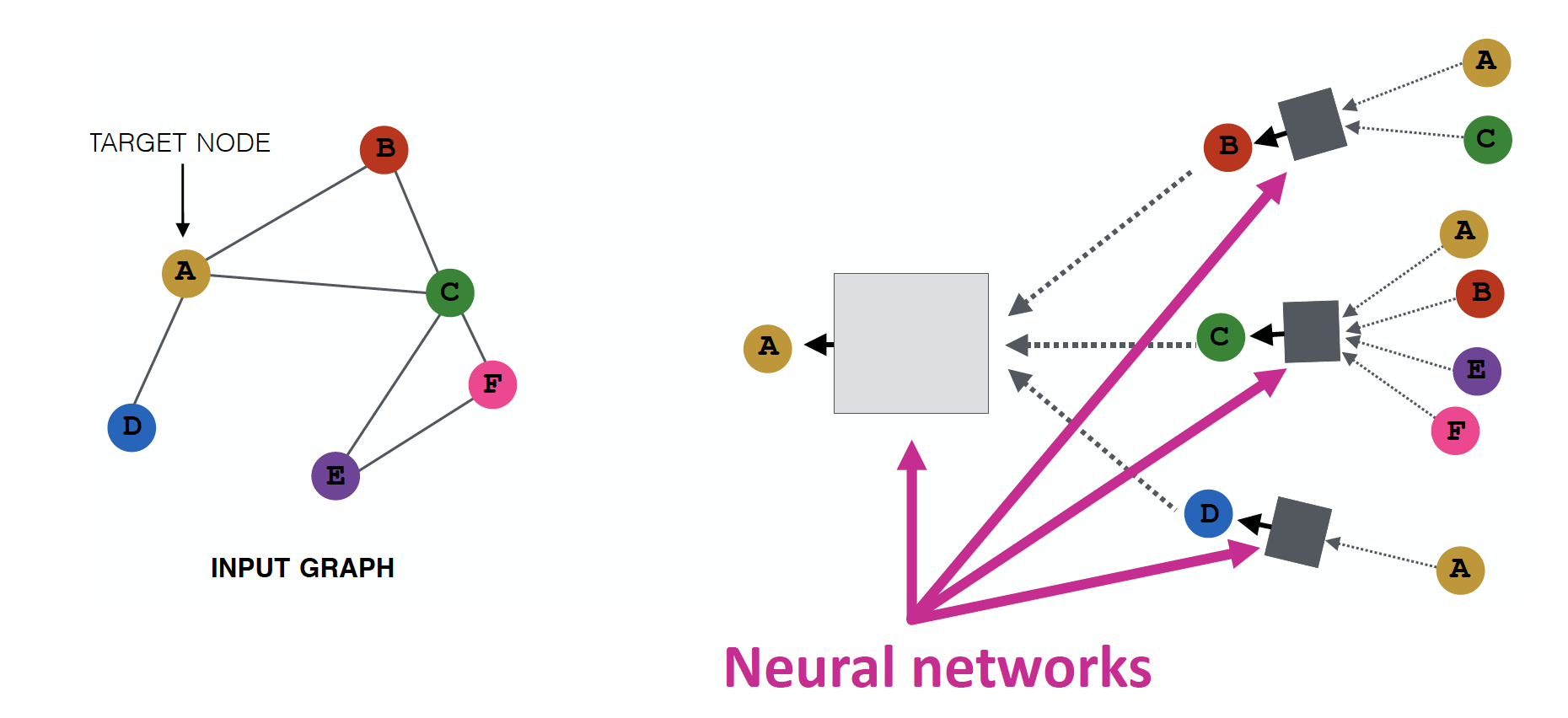
Intuition 2
neighborhood 가 computation graph 를 결정합니다.
모든 node들은 자기 자신만의 Neural Network Architecture 를 갖고 있으며, 각자의 neighborhood에 근거하여 computation graph를 정의합니다.
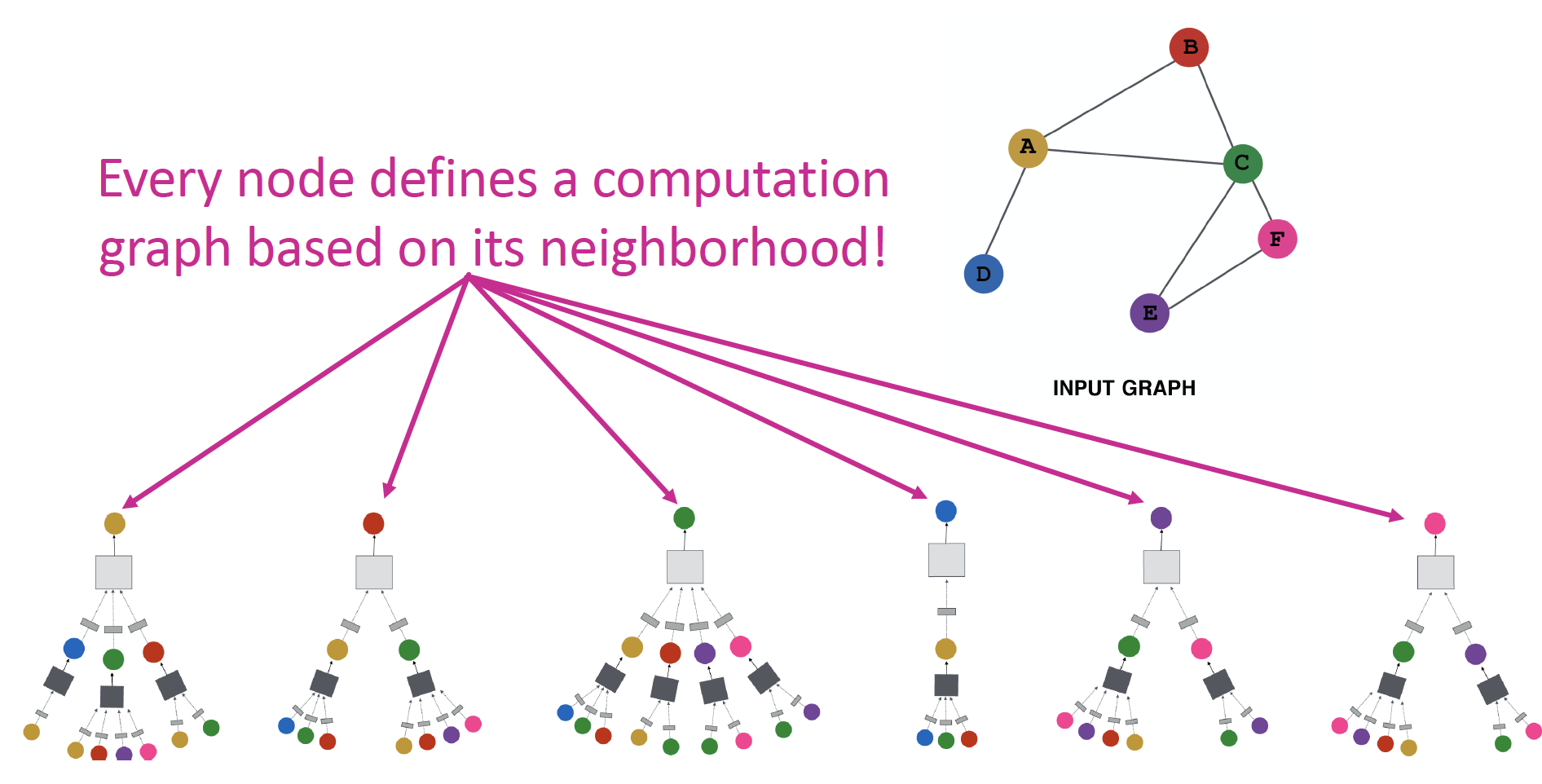
Neighborhood Aggregation
Neighbors 로 부터 정보를 모아 Average 한 뒤, Neural Network 를 적용합니다.
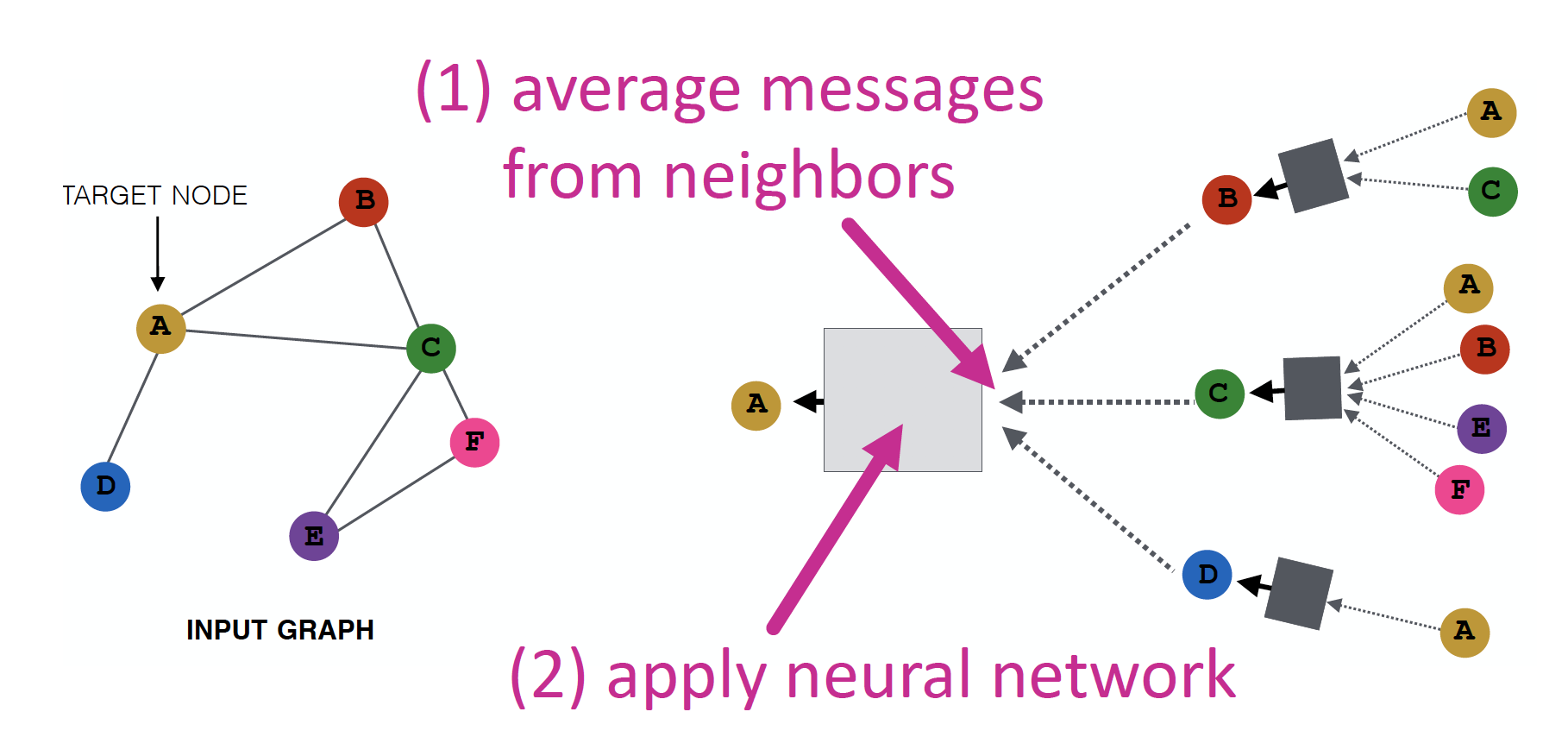
Models
Deep Layer Model
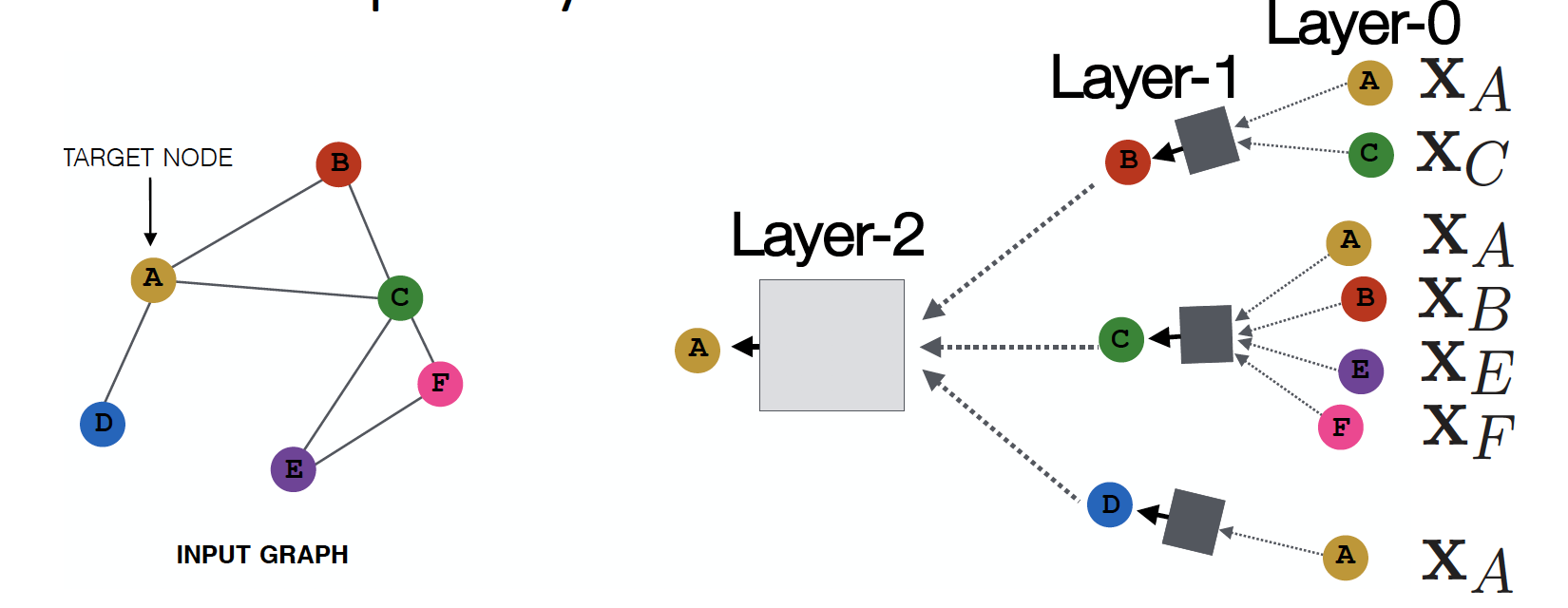
Model의 depth는 자유롭게 설정할 수 있습니다.
- Node는 각 layer에서 embedding 값을 가지게 됩니다.
- Layer-0에서의 node A의 embedding 은 가 됩니다.
- Layer-K에서의 embedding 은, Layer-0 에서 시작하여 Hidden Layer를 거쳐 K번 전달된 정보에 대한 값을 가지게 됩니다.
Deep Encoder
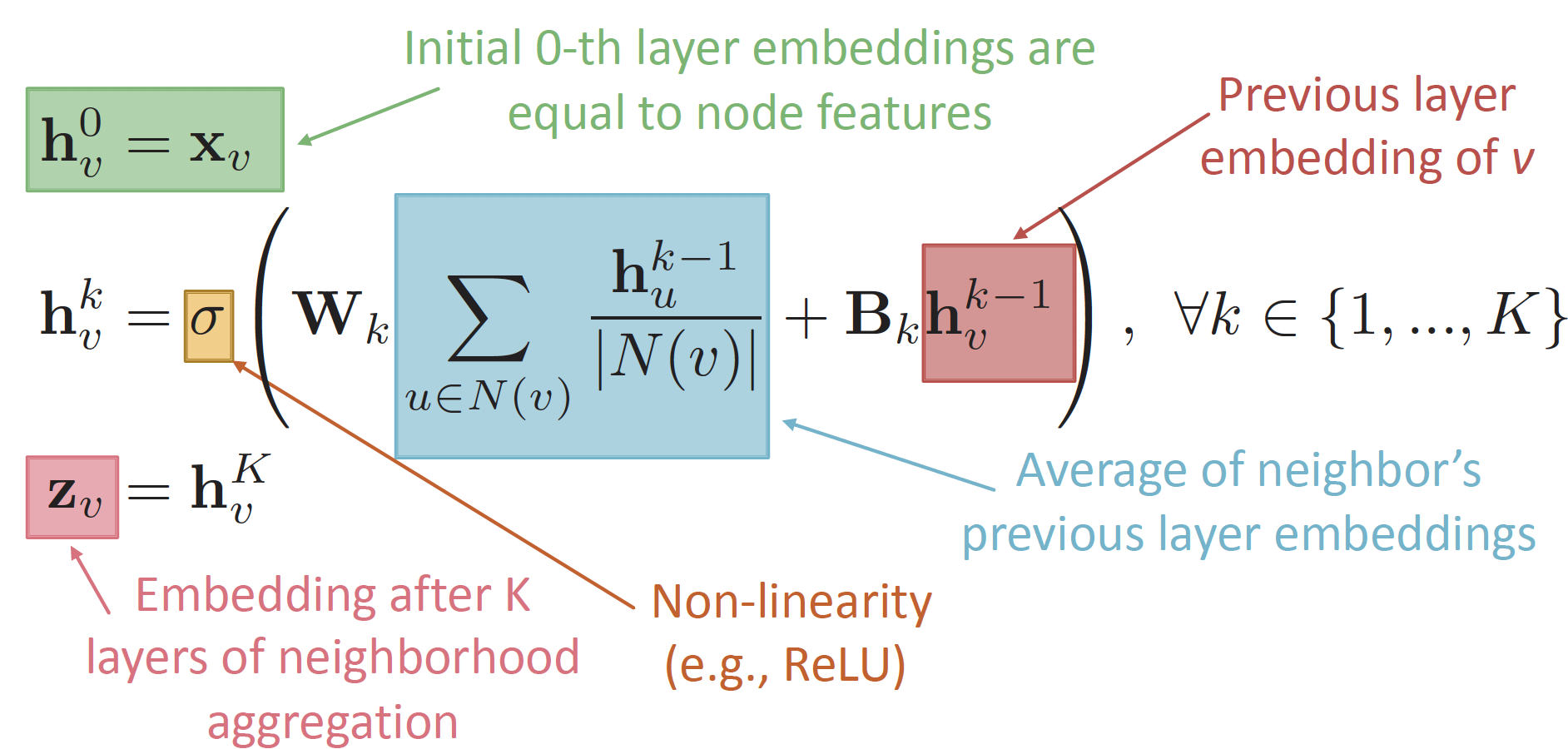
정보가 전달되어 embedding 값을 가지게 되는 과정을 수식적으로 표현하면 위와 같습니다.
W: Average of neighbor's previous layer embeddingsB: Message myself from the previous layer
Training the Model

위의 식에서, Train의 대상은 Weight Matrix 인 W 와 B 입니다.
W 와 B 비율을 통해, friend / own property 중 어디에 더욱 주목할 지 결정합니다.
W↑ ,B↓ : Neighbor 정보 더욱 많이 고려W↓ ,B↑ : 이전 레이어의 자신의 정보를 더욱 많이 고려
embedding 값은 어떠한 loss function에도 적용 가능하며,
Stochastic Gradient Descent 를 통해 Weight를 update 합니다.
Loss Function은 Task에 따라 달라집니다.
1. Unsupervised Training

Task : graph structure 를 고려한 node embedding
- node u 와 node v 가 similar 할 때, 이 됩니다.
- CE : Cross Entropy
- DEC : Decoder (ex. inner product)
- Loss Function : Random Walks, Graph Factorization, Node Proximity in the Graph
2. Supervised Training
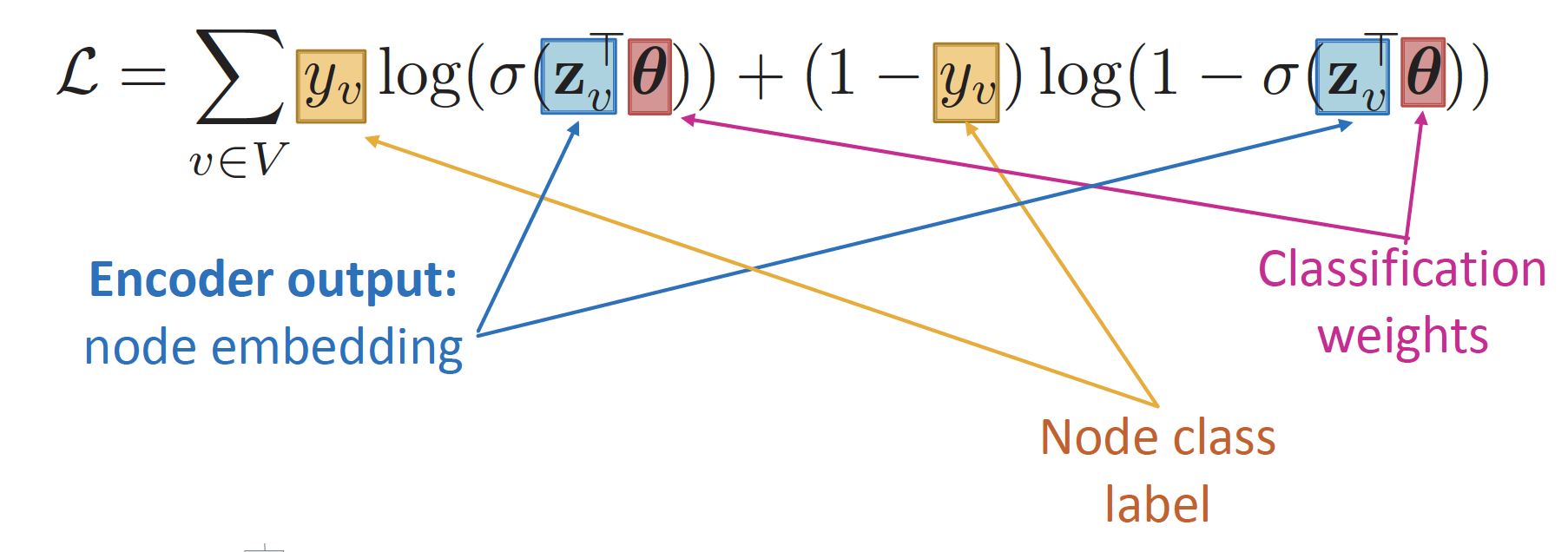
Task : node classification
- Cross Entropy Loss
- : ground-truth label
- Positive node 라면 값이 커지고, Negative node 라면 값이 커지게 됩니다.
Overview
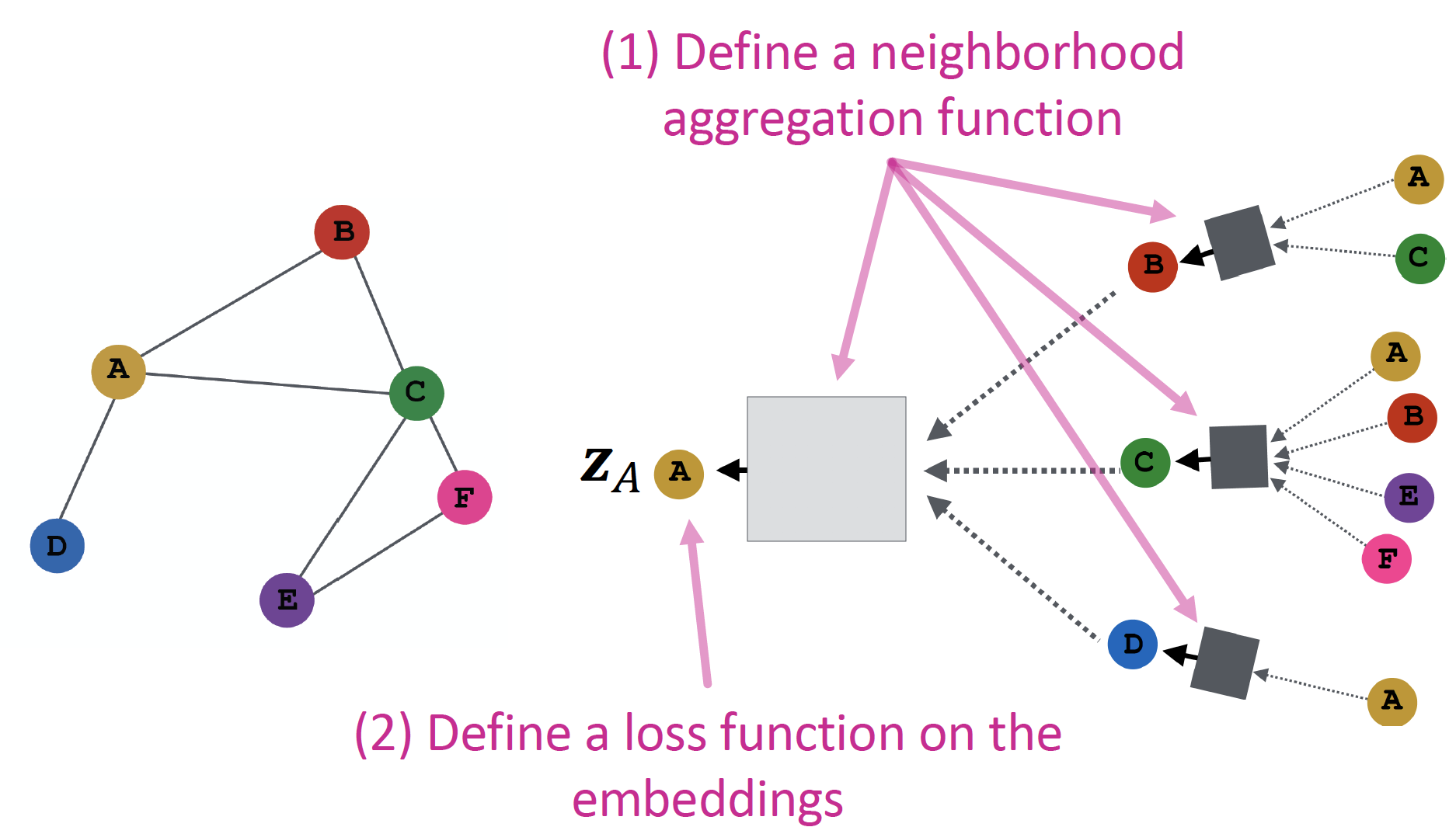
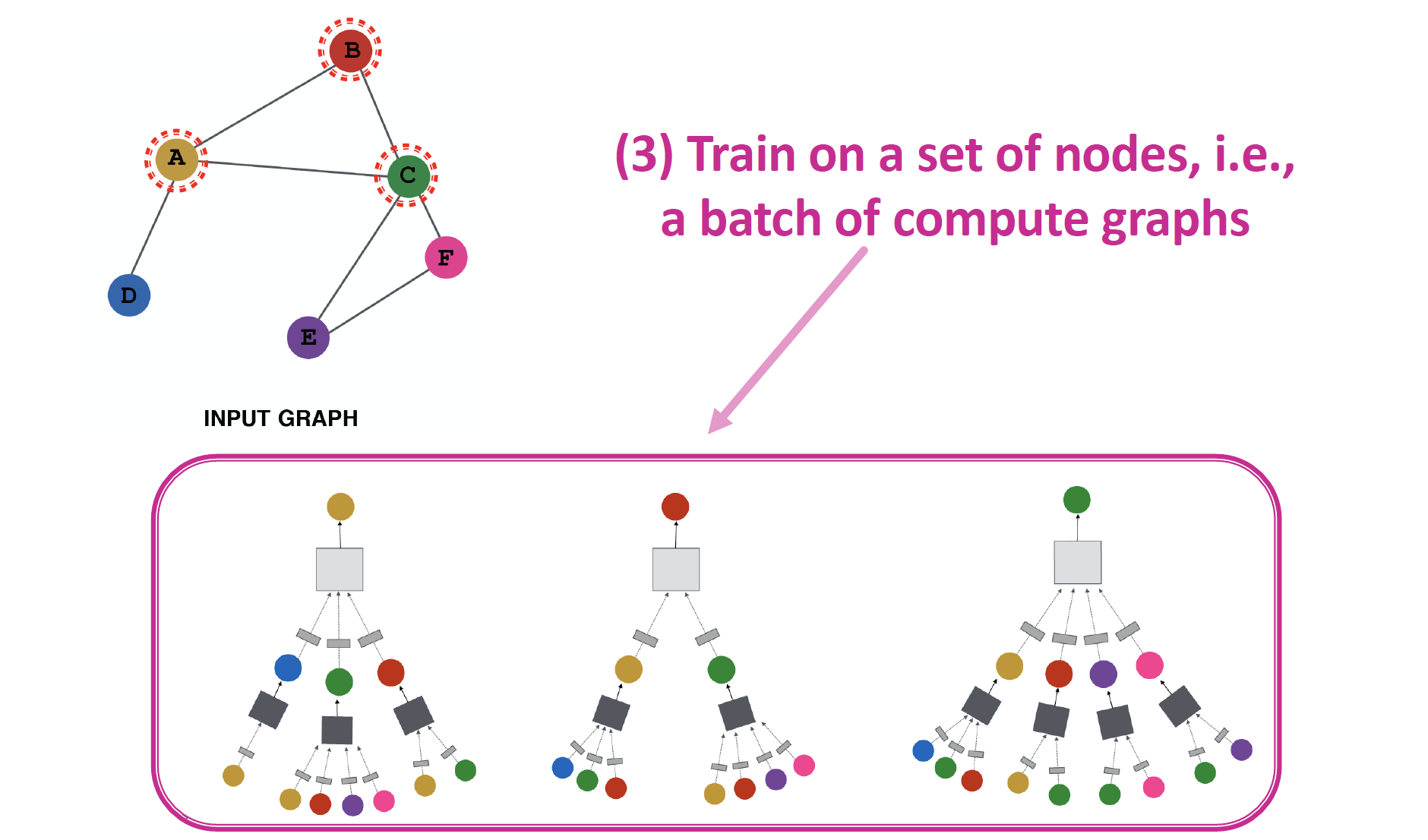
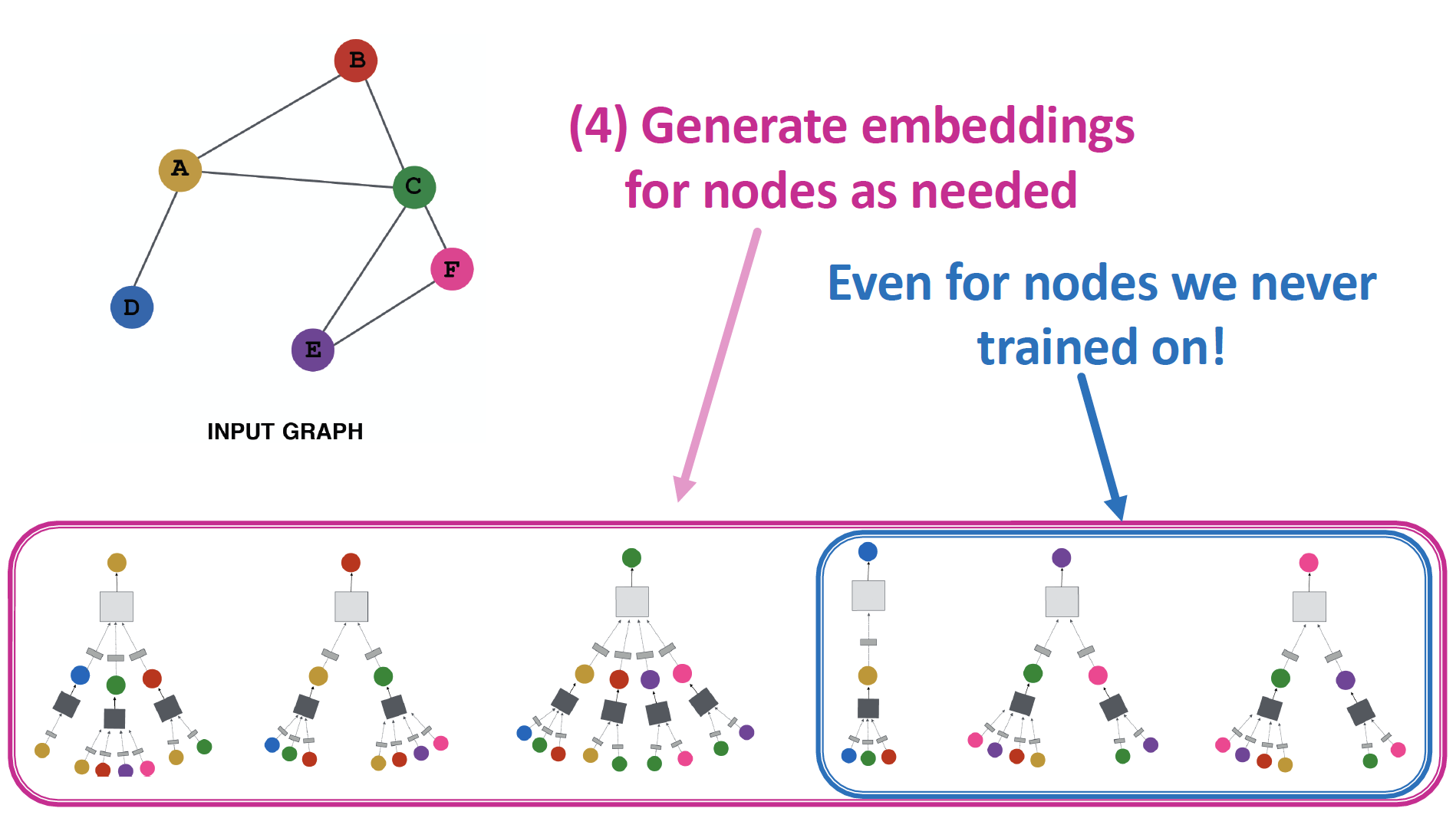
Parameter Sharing

The same aggregation parameters are shared for all nodes
new nodes & new graphs 에 대해서도, generalize 가능합니다.
Summary
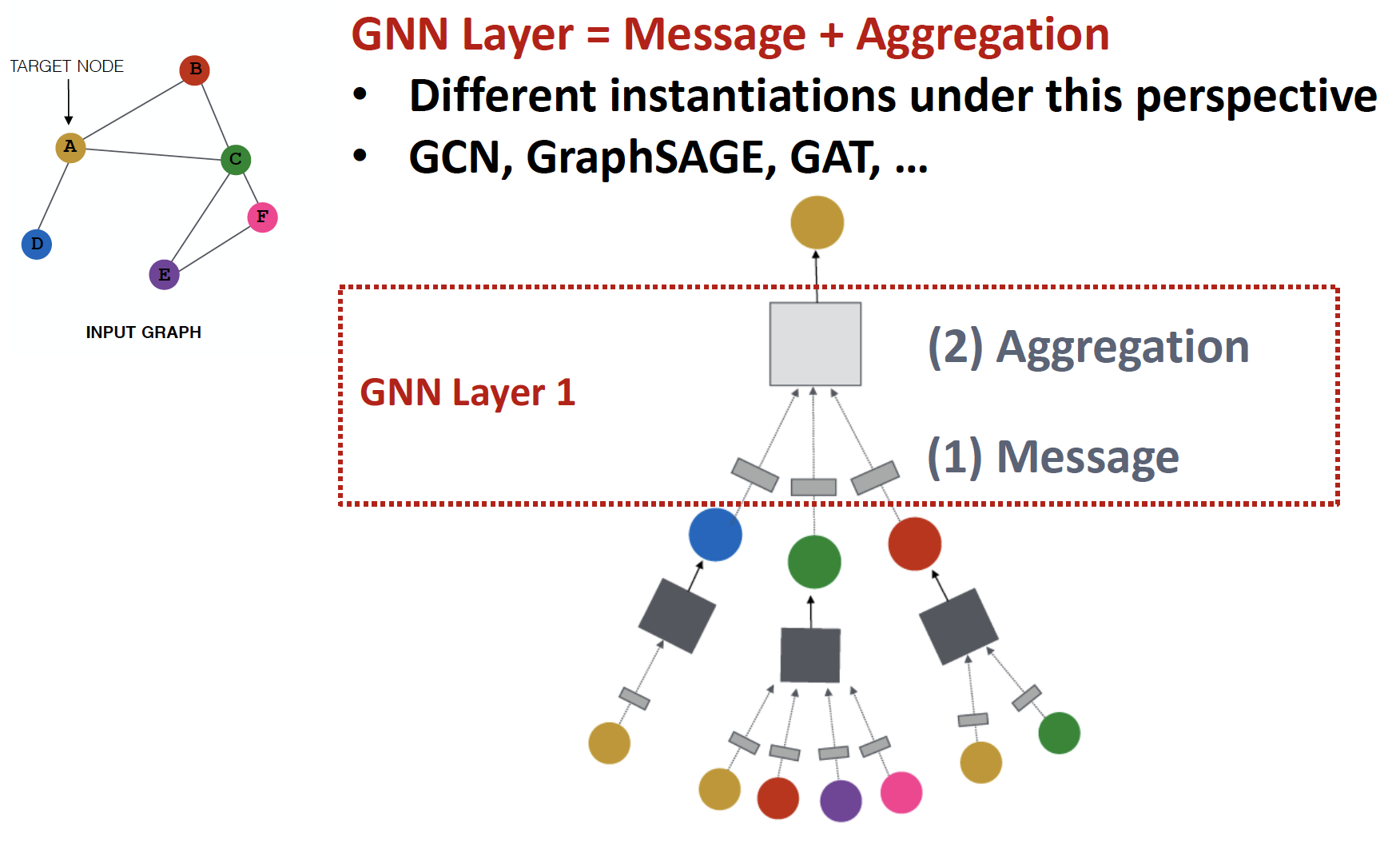
Generate node embeddings by aggregating neighborhood information
Graph Neural Network
Layer에서 Neighborhood 와 자기 자신의 message 를 Aggregate 하여 embedding 을 만들고, 이를 전달하여 최종 target node의 embedding 을 만드는 것입니다.
2. Graph Convolutional Network (GCN)
Matrix Formulation

k-1 hidden layer에서 information aggregation을 통해 k hidden layer 로 전달하는 Neighborhood Aggregation 식은 위와 같습니다.
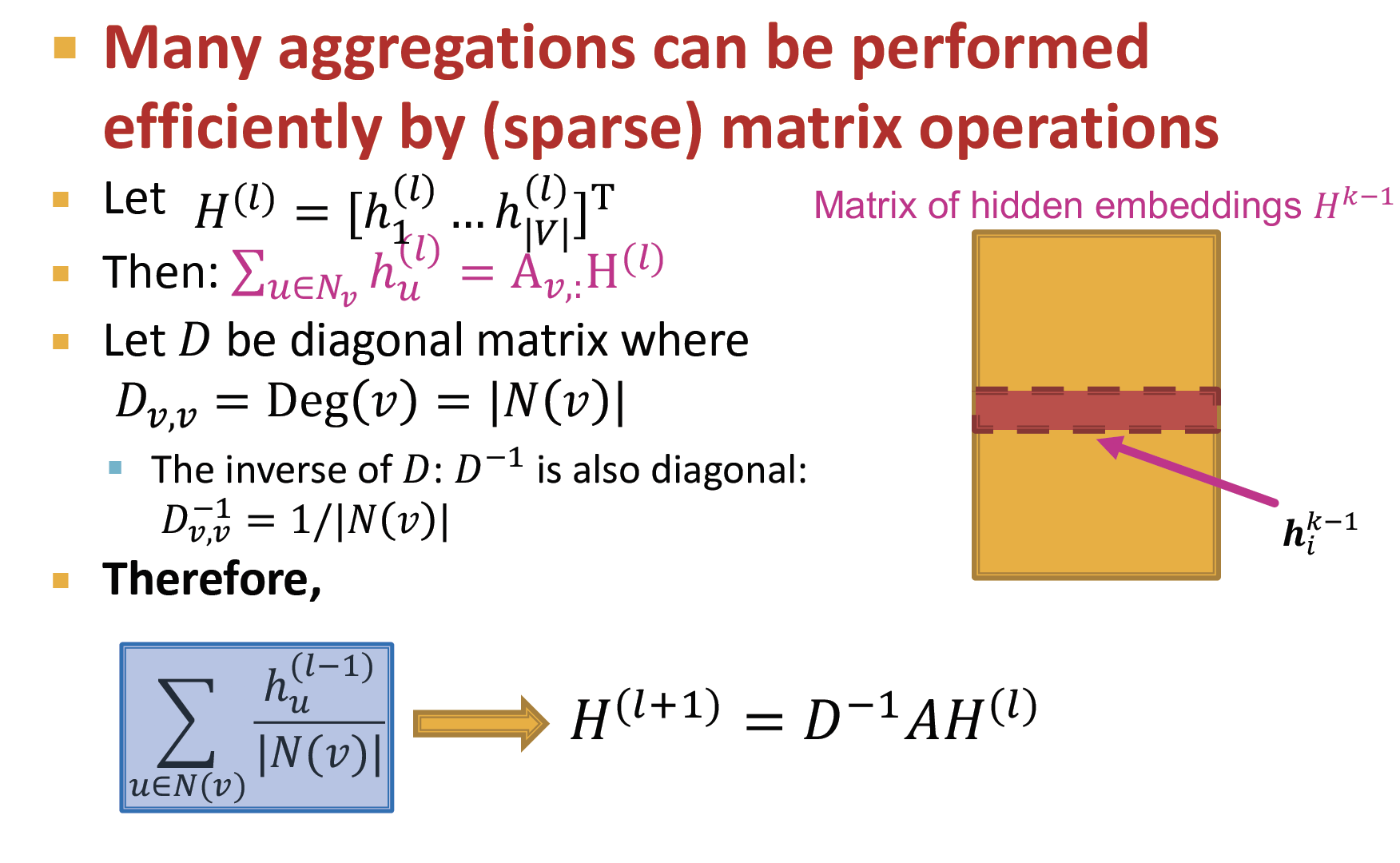
(인접행렬)은 node 연결 여부에 대한 정보(0/1)를 담고 있는 행렬입니다.
따라서 는 node i 와 relationship이 있는 state 값만 더한 값으로 update 한다는 의미입니다.
여기에 을 곱해 row normalized matrix 를 만들어 냅니다.
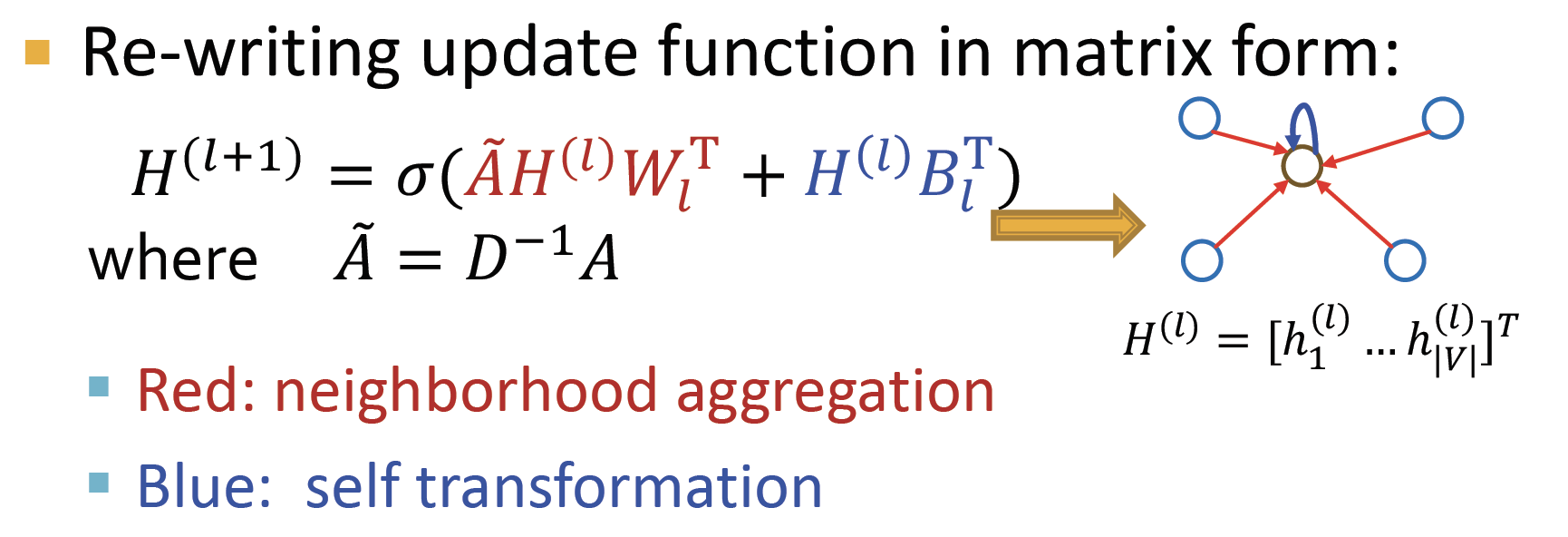
Neighborhood Aggregation 식을 vector form 으로 표현하면 위와 같습니다.
Graph Convolutional Networks
idea
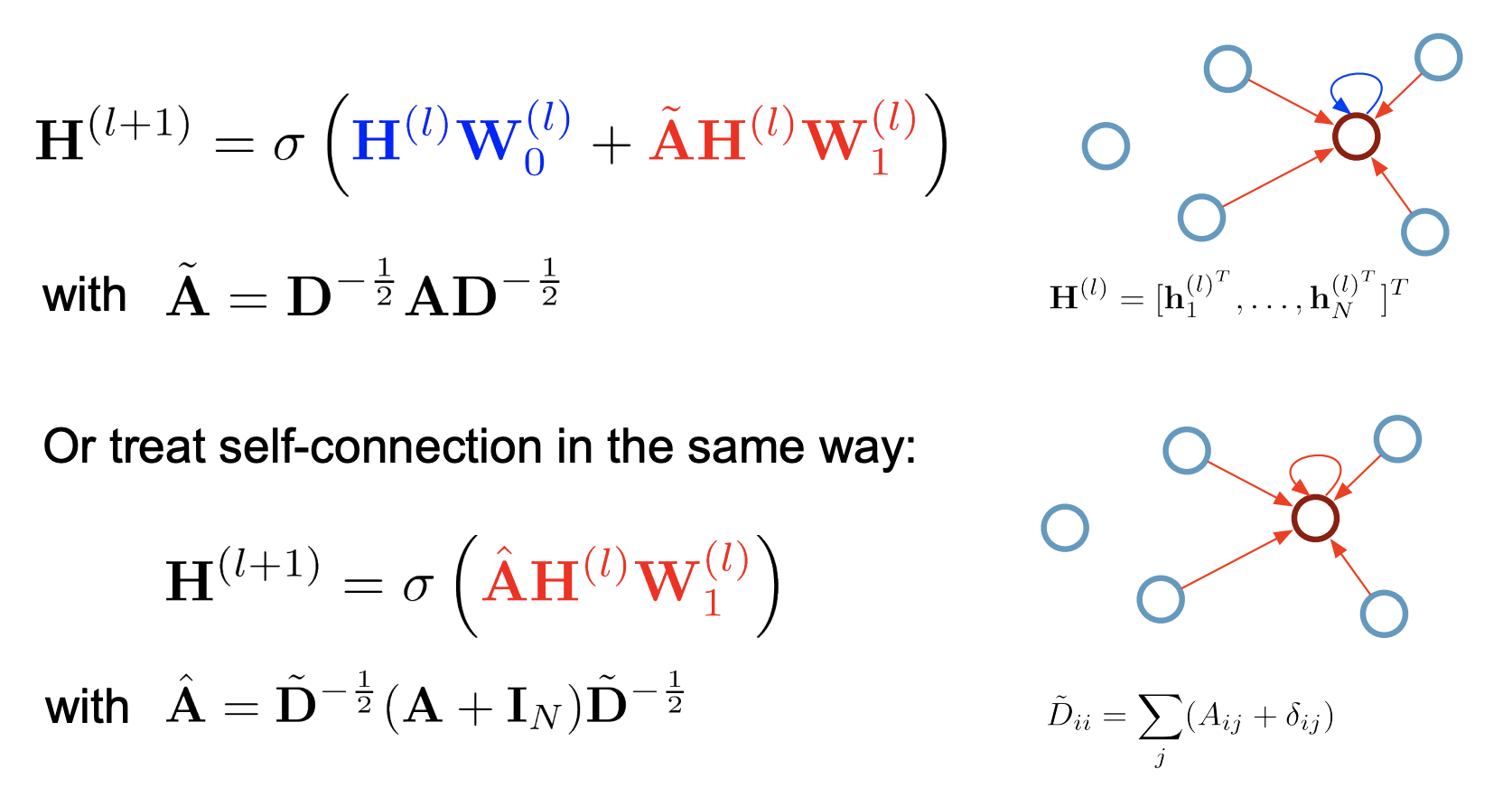
-
neighborhood aggregate 에는 를 사용하였고, previous self embedding 에는 를 곱했는데 → GCN 에서는 neighbor 와 self 모두에 대해 동일한 parameter 인 를 사용합니다.
-
인접행렬()을 사용하게 되면 자기 자신으로의 연결을 고려하지 않게 되므로 → self-connection을 추가한 행렬을 사용합니다.
-
단순히 neighborhood 정보의 평균 ()을 구하지 않고 → neighborhood aggregation 에 symmetric normalization ()을 적용하여 계산합니다.
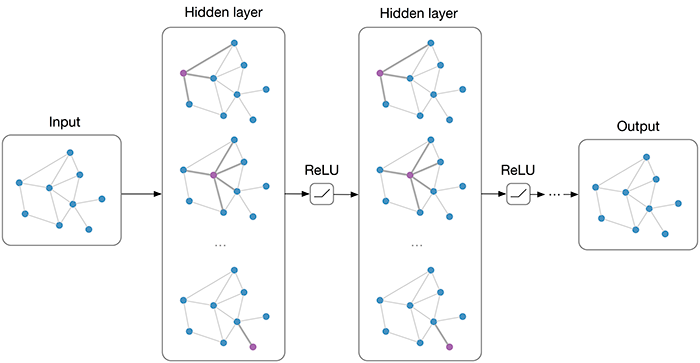
- graph 에서 , 를 얻습니다.
- 각 node에 연결된 edge 개수에 대해 normalization 을 진행합니다.
- l번째 hidden state 인 을 곱합니다.
- 학습 가능한 parameter 을 곱합니다.
- activation function 를 거쳐 비선형성을 학습합니다.
Output : 인접 노드들의 가중치 feature vector W의 합
즉, GCN은 특정 node의 representation으로, 해당 node에 연결되어 있는 node들을 가중합하는 방법입니다.
GraphSAGE
idea
Concatenateneighbor embedding & self embedding- 다양한
Aggregation방법론을 적용합니다.
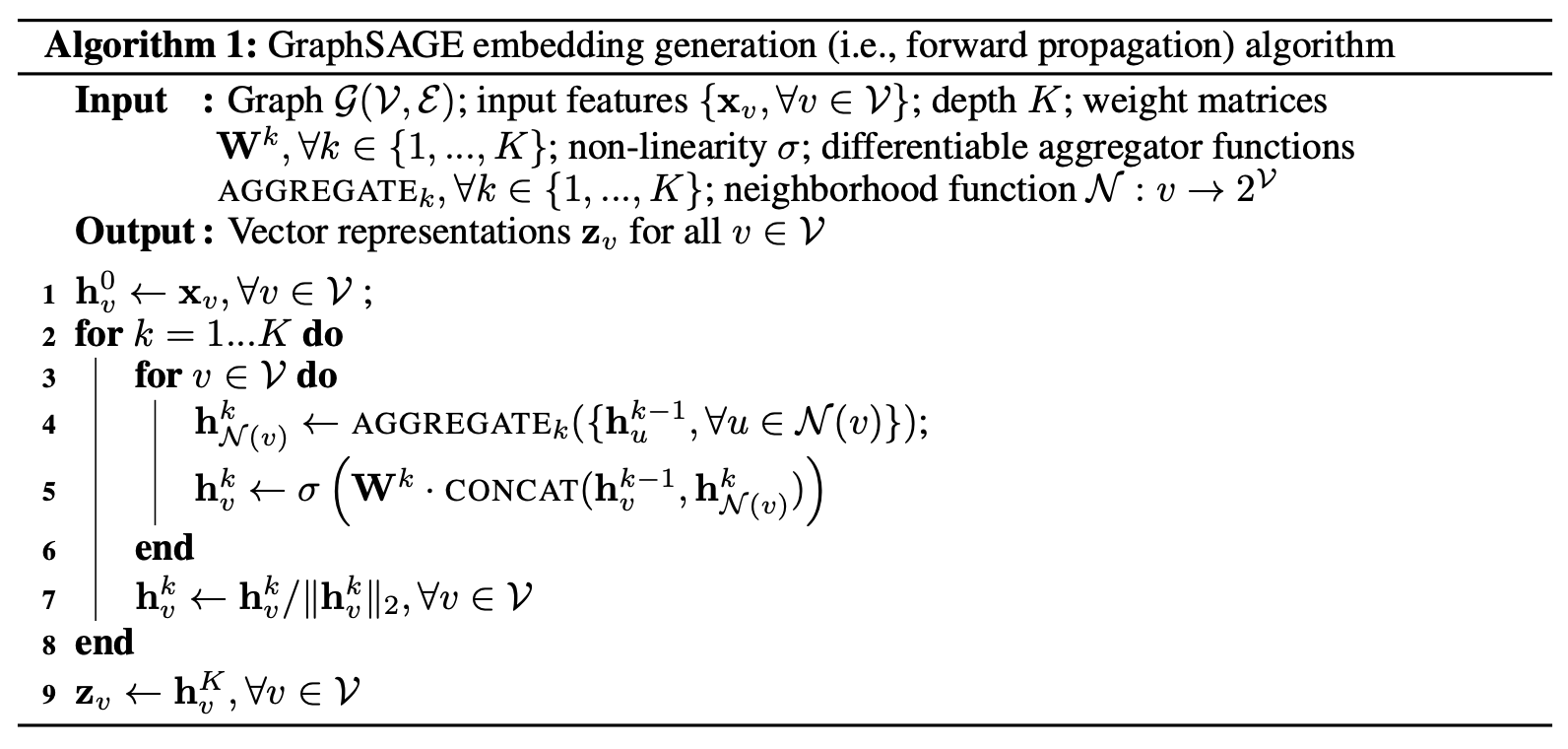
-
GCN : neighbor 과 self 의 message 를 더합니다.

GraphSAGE : neighbor 과 self 의 message 를 concat 합니다.

-
Aggregation방법은 여러 가지가 있습니다.
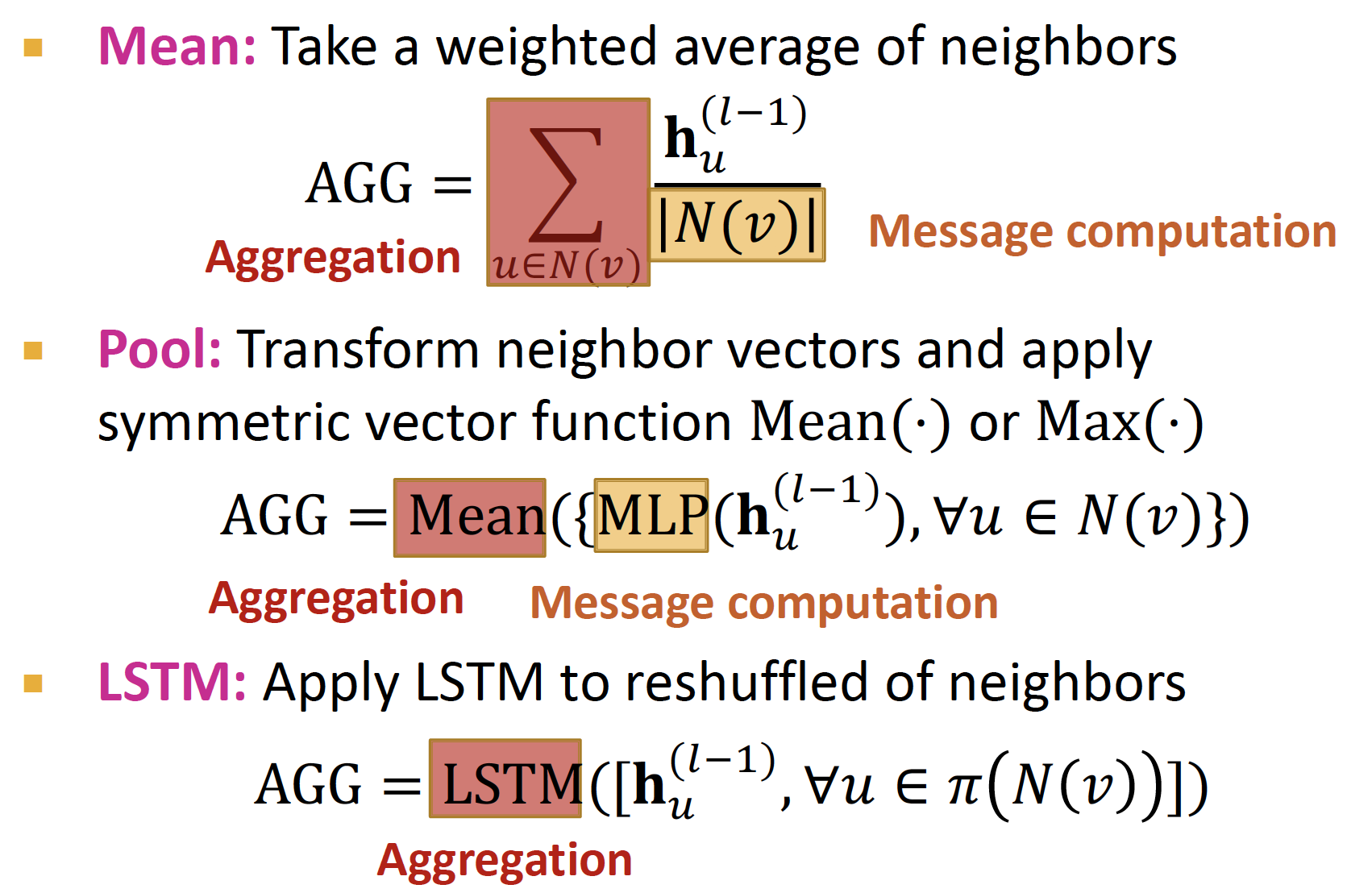
3. Graph Attention Network (GAT)

각 neighborhood node들의 중요도를 같다고 보지 않고 (), attention coefficients 를 적용해 neighborhood node 마다 가중치를 다르게 적용합니다.
Attention Mechanism in NLP
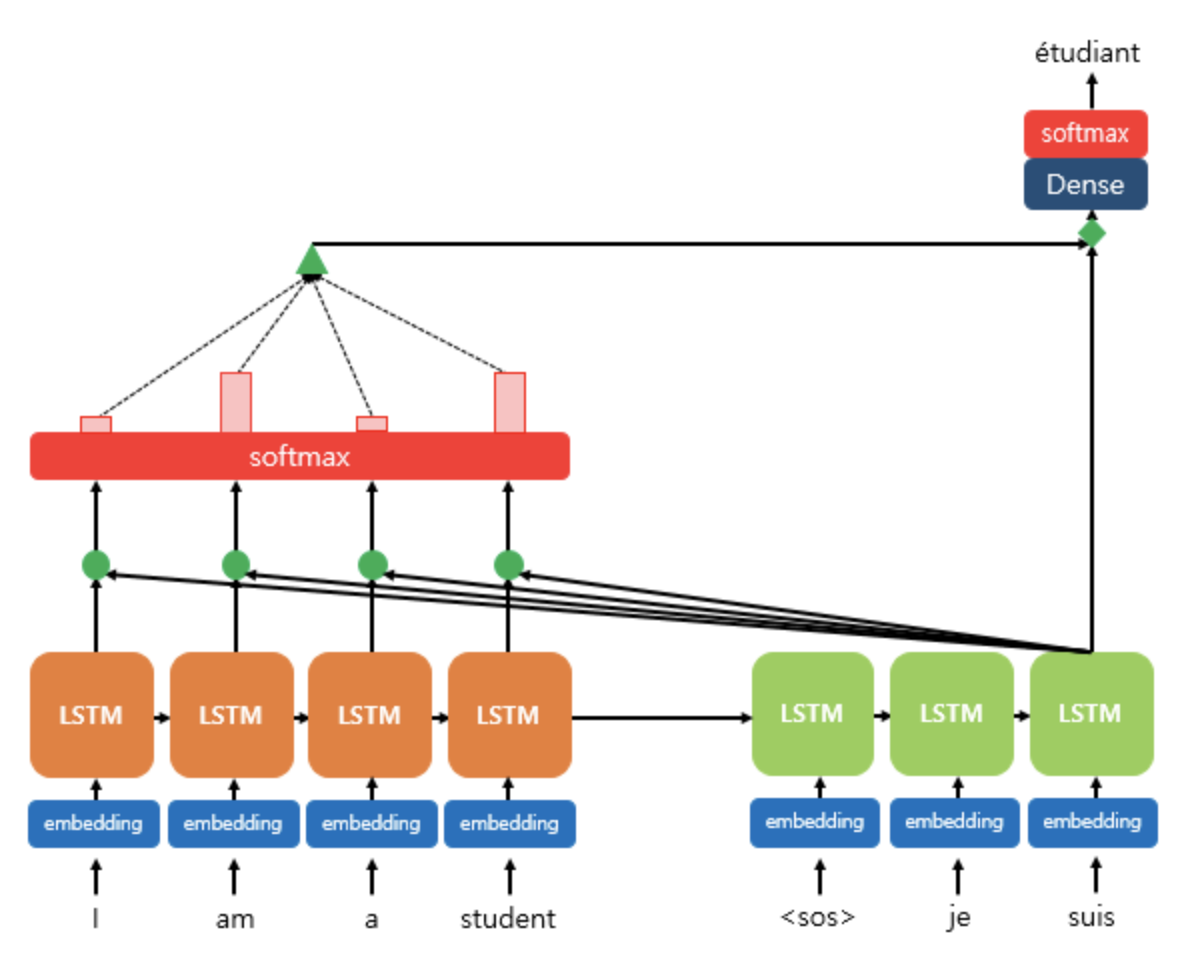
출력 값을 예측할 때, encoder의 모든 입력 단어들의 정보(확률값)를 다시 한번 참고하여 손실했던 정보를 반영합니다.
encoder 에서 나온 hidden state 에, 현재 시점 t에서의 decoder hidden state 값을 dot product 연산을 통해 구합니다.
attention distribution 을 구합니다.
encoder의 hidden state와 Attention Weights를 곱하고, Weighted Sum 합니다.- = concat(, )
attention value 와 decoder hidden state 값을 concat 한 후, 최종 layer 를 통과하여 output 을 계산합니다.
Attention Mechanism in Graph
PROCESS
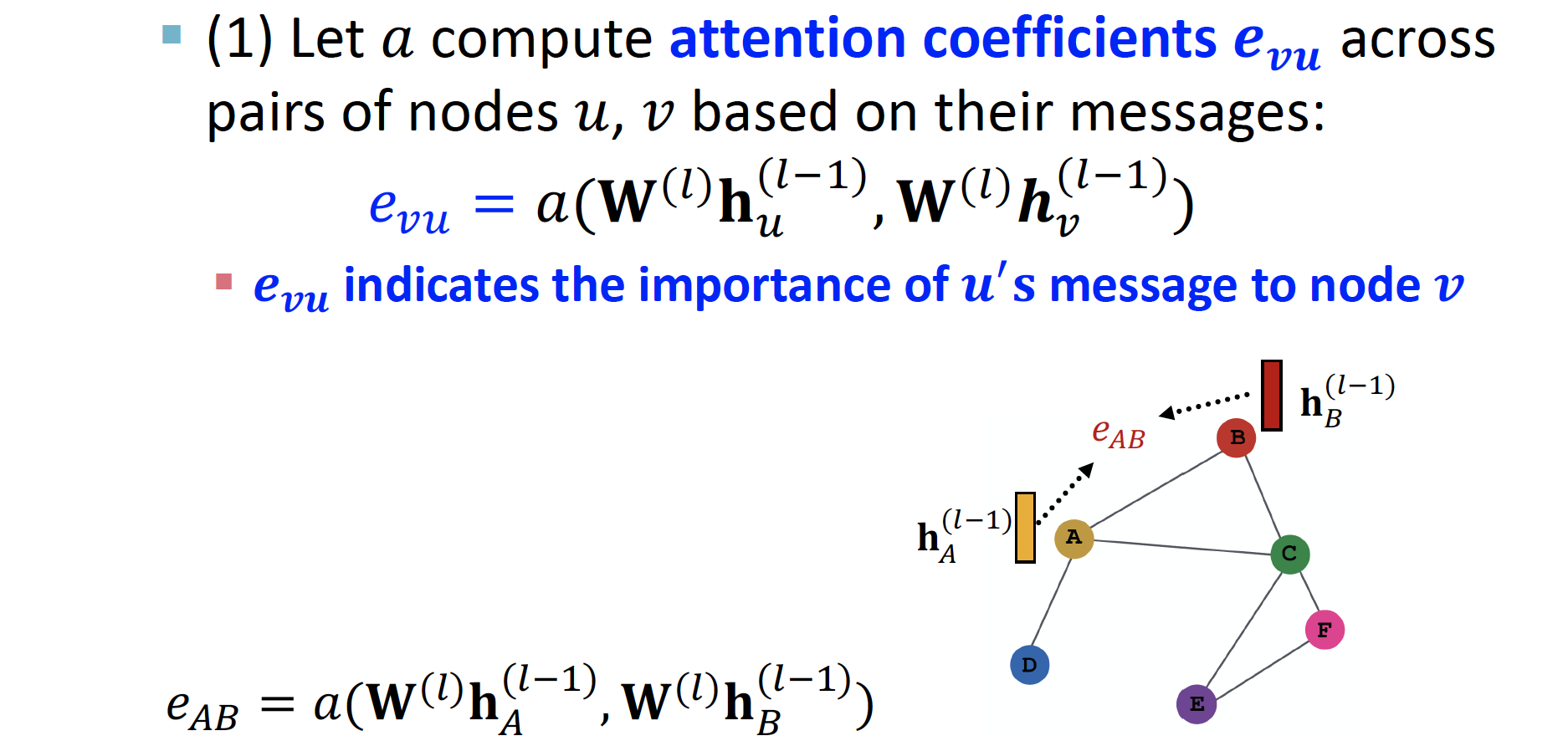
를 통해서 노드 에서 노드 로 가는 message importance 를 계산합니다.

각 node 의 hidden state 값이 concat 되고, linear 를 거쳐 attention coefficient 가 계산됩니다.
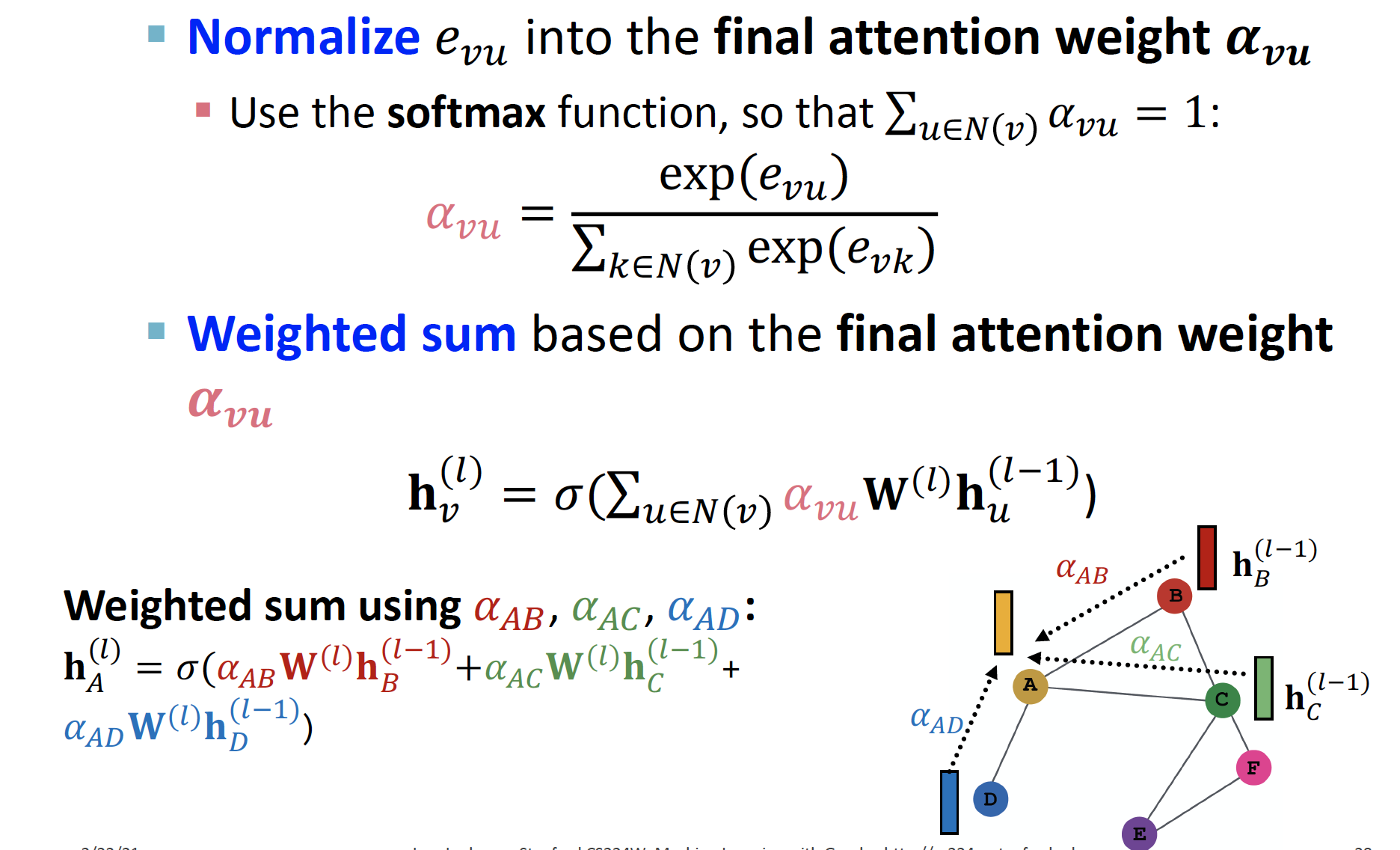
softmax 함수 를 거치고, 이를 통해 나온 값 을 곱해 가중합 하여 을 계산합니다.
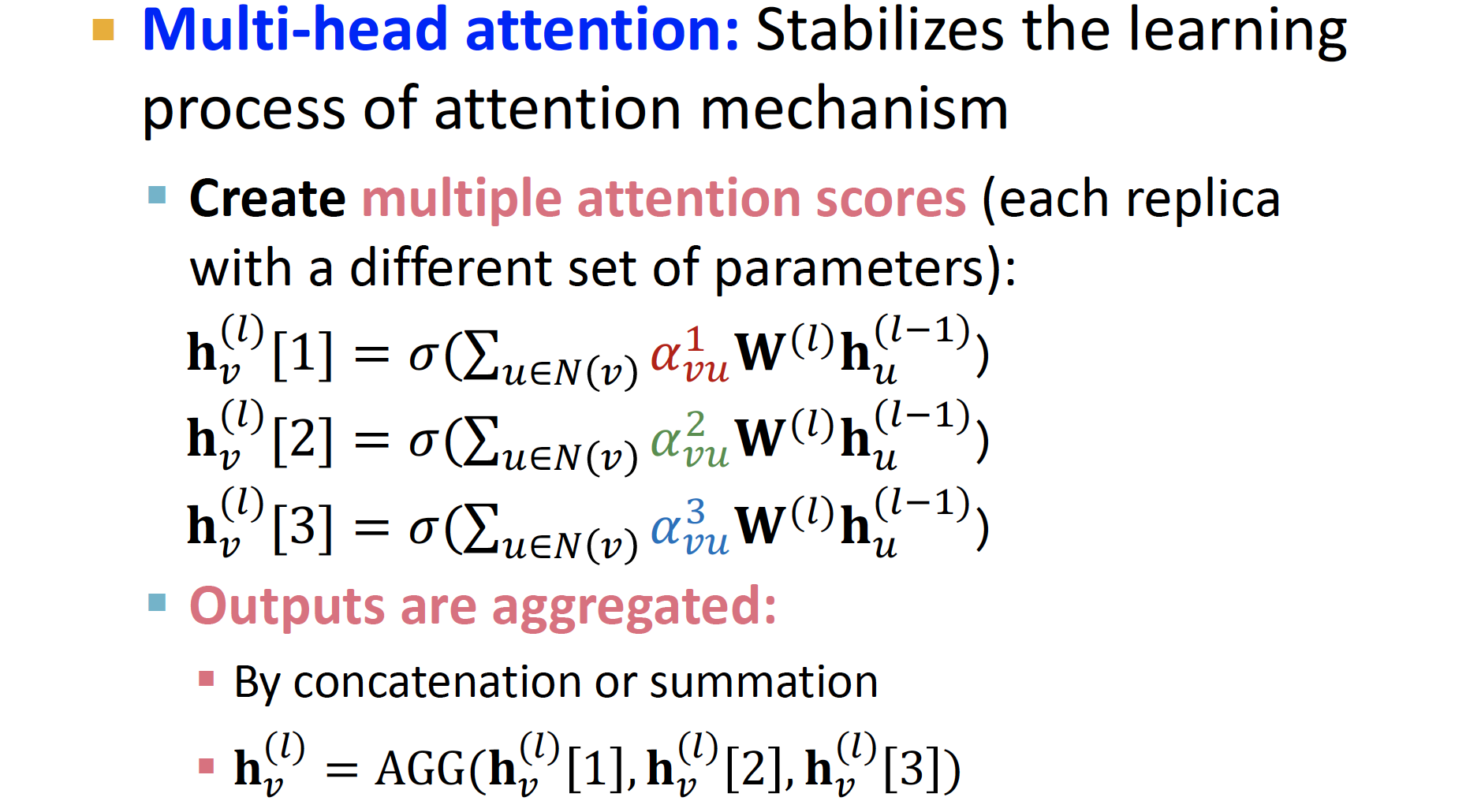
Multi-head attention 을 통해 값을 여러 개 도출하여, 이를 aggregate 해서 최종 output을 계산합니다.
✔︎ Multi-head attention : 서로 다른 attention mechanism을 여러 번 계산하여, input을 여러 관점(head)에서 해석
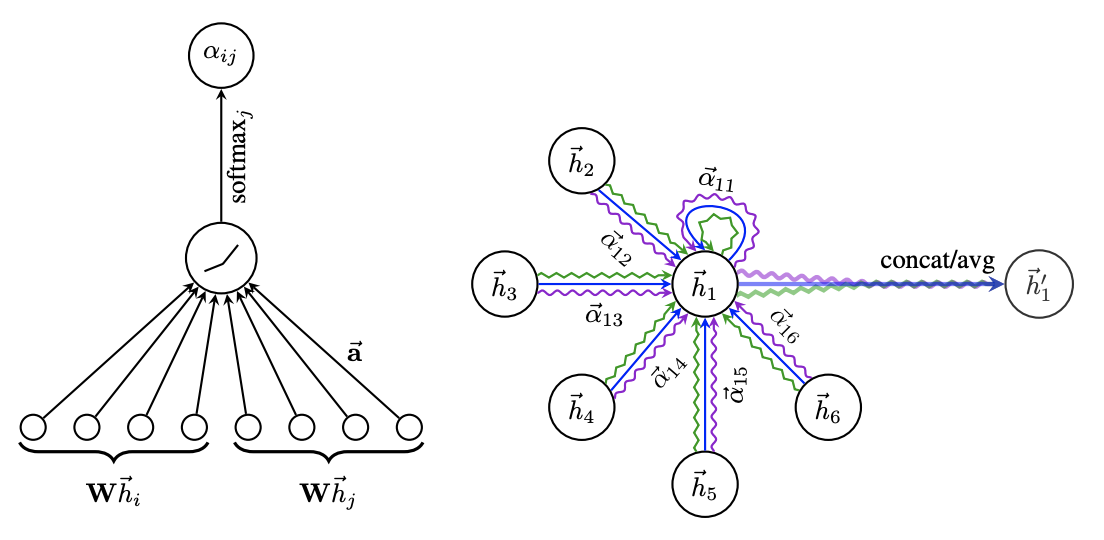
Allows for (implicitly) specifying different importance values to different neighbors
Experiments
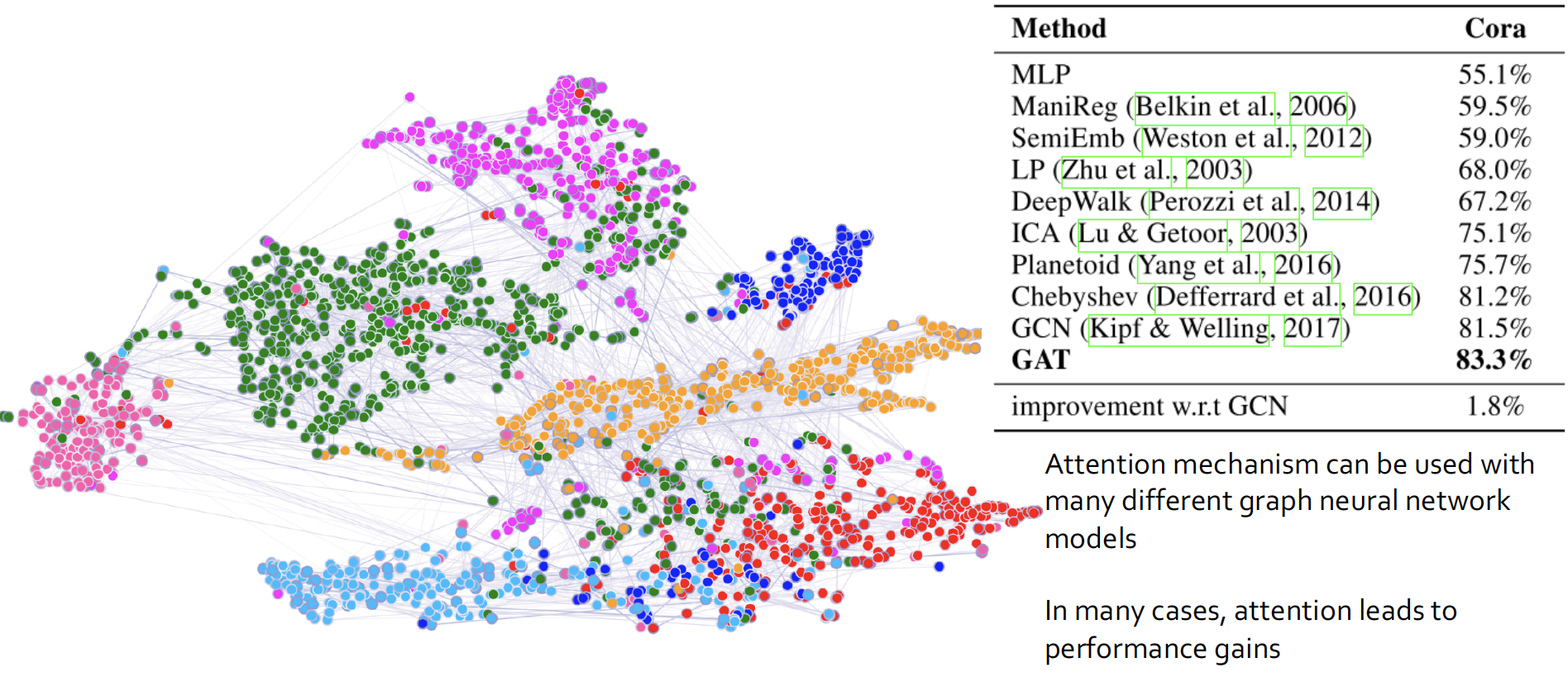
MLP 보다는 Random Walk 가, 이보다는 GCN 과 GAT 가 훨씬 성능이 좋다고 합니다.
4. Application
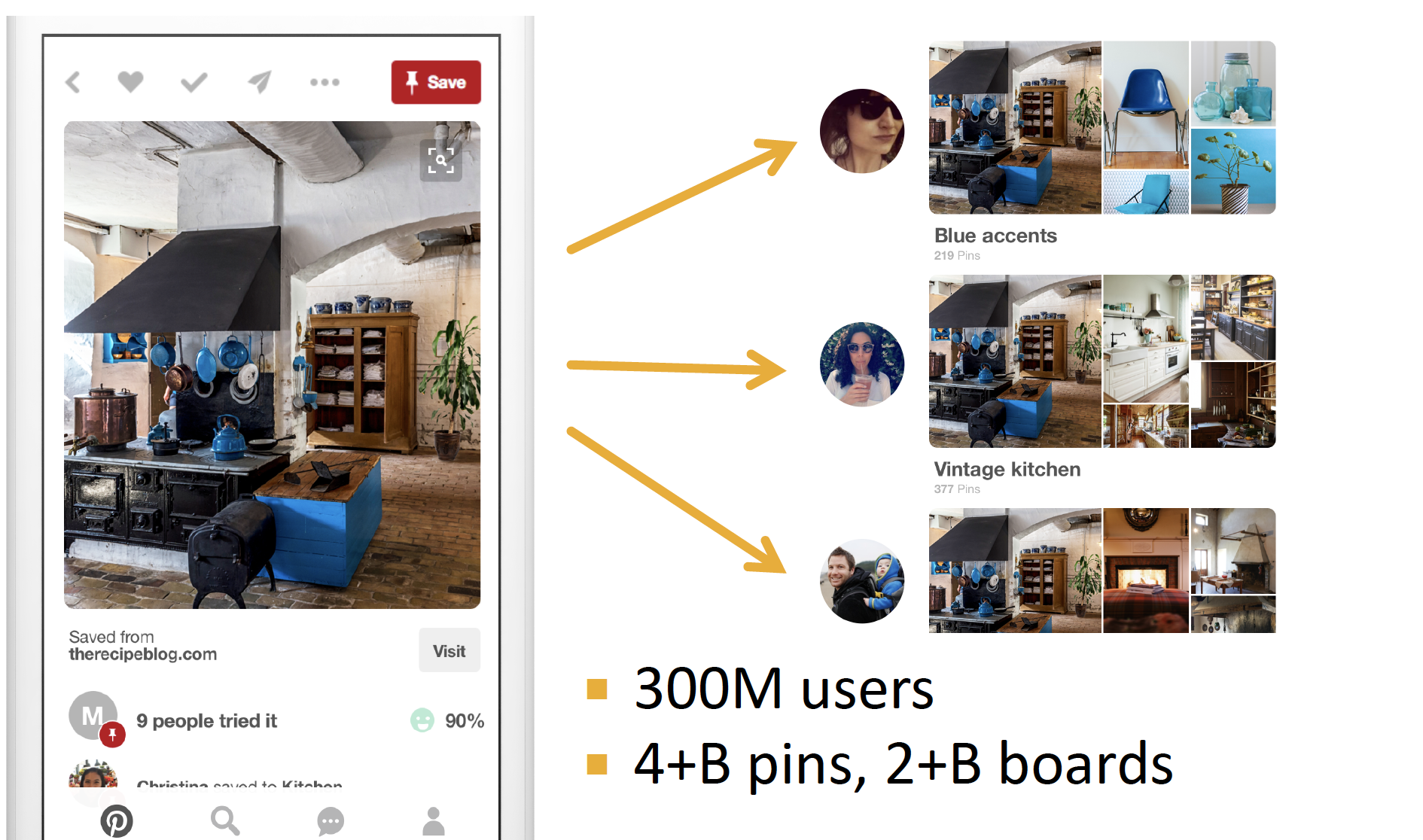
Graph 를 이용해서 더 나은 Recommendation 결과를 도출합니다.
PinSAGE
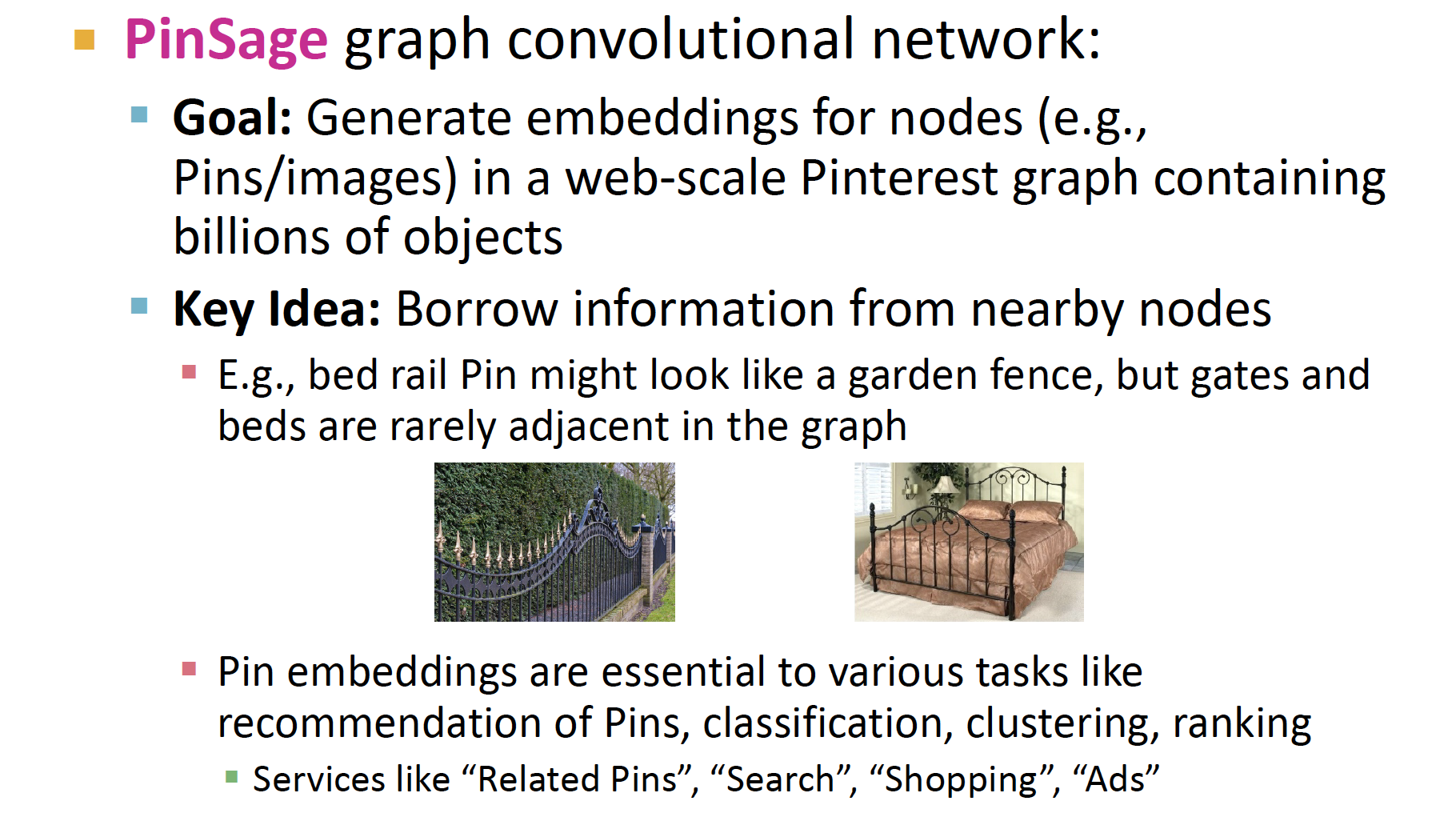
visual 로만 구분하면, fence 와 bed 를 제대로 구분할 수 없게 됩니다.
따라서 Image 와 이를 한 곳에 모아 놓은 Pins 를 node 로 하여, bipartite graph 를 구축해 좀 더 나은 추천 결과를 도출합니다.
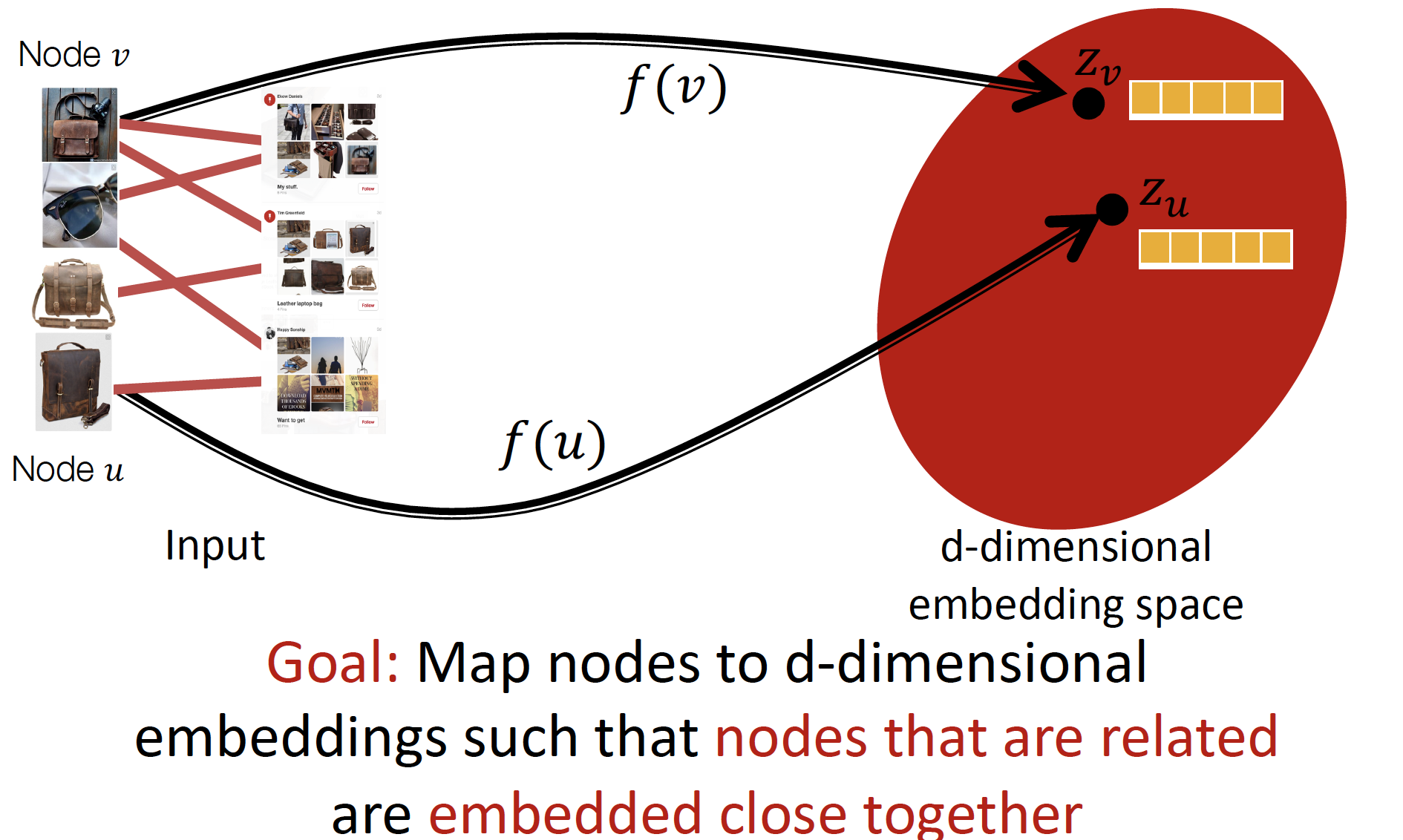
node v image 를 embedding 하여, similar 한 node u 를 찾고, node u의 neighbor 를 추천해 줍니다.
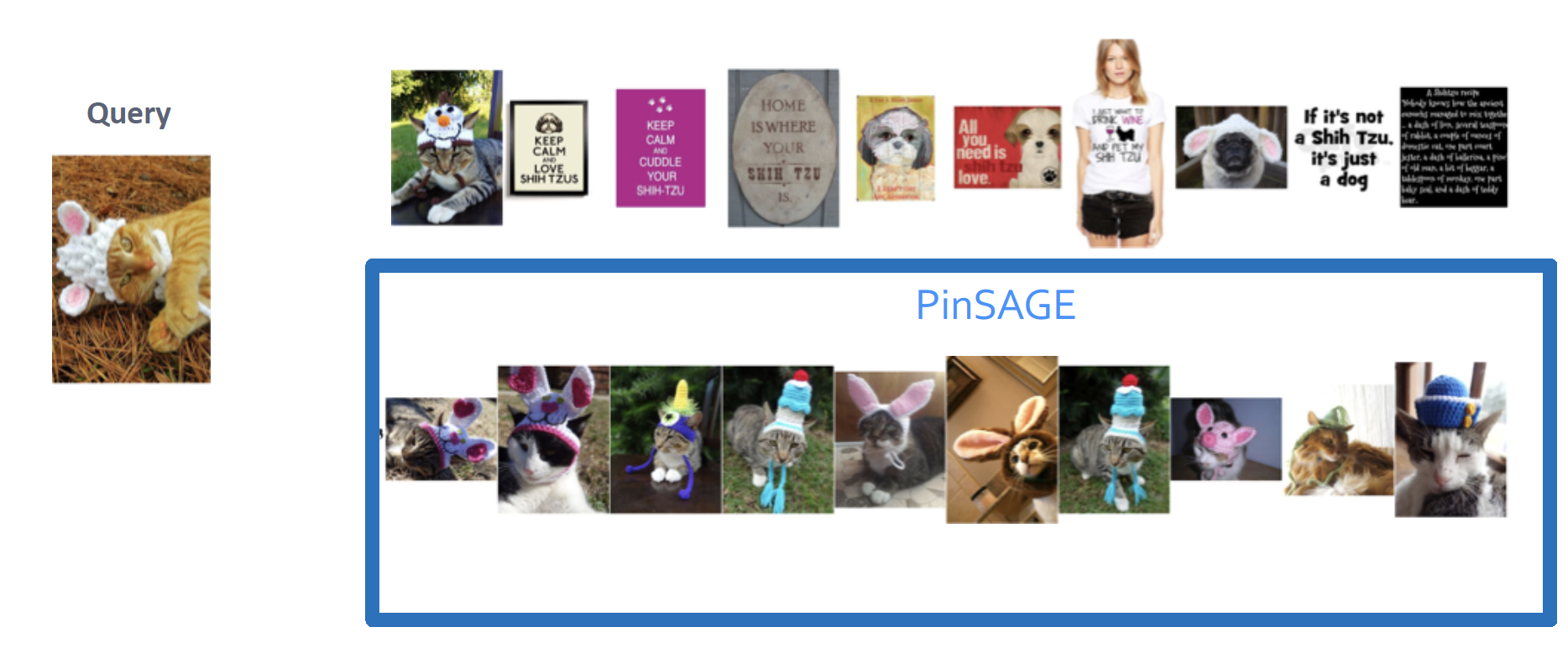
Graph 적용 시 훨씬 좋은 추천 결과를 보인다고 합니다.
Reference
Reviews
- Tobigs Graph Study : Chapter8. Graph Neural Networks
- 데이터 괴짜님 Review : CS224W - 08.Graph Neural Networks
- snap-stanford Review : Graph Neural Networks
CS224W Winter 2021
- Lecture 6. Graph Neural Networks - 1: GNN Model
- Lecture 7. Graph Neural Networks - 2: Design Space
GCN
- Paper : Semi-Supervised Classification with Graph Convolutional Networks
- Review : Graph Convolutional Networks
- PyTorch Code : tkipf/pygcn
- reference links
- GraphSAGE : Inductive Representation Learning on Large Graphs
GAT
- Paper : Graph Attention Networks
- PyTorch Code : Diego999/pyGAT
- reference links
etc.
- 컨볼루션(Convolution) 이해하기
- jihoon님 Review : Graph Neural Network
- Deep Learning on Graphs with Graph Convolutional Networks
- Interpretation of Symmetric Normalised Graph Adjacency Matrix?
- lee-ganghee님 Review : GNN, GCN 개념정리
- wikidocs : 어텐션 메커니즘 (Attention Mechanism)
- Yeongmin님 GCN Paper Review : Graph Convolutional Networks Review

reference 미쳣네여...